Is the "old" well forgotten to become the "new"? Part-2. At the call of honor and duty
1. The armor protection of domestic armored personnel carriers, infantry fighting vehicles and BMD poorly protects even from small arms fire. weapons (also valid for some foreign samples).
We recall that when we became acquainted with the terms "BTR", "BMP", "BMD", then we heard something about the protection from fire of conventional means of destruction and anti-bullet armor. So here.
Under the term military small arms fall into products in caliber from 5,45 to 14,5 mm, inclusive, from pistols to heavy machine guns. However, from this range it is worthwhile to consider only regular weapons of motorized rifle subunits, limited to 7,62 mm caliber (9 mm), since the 12,7 mm caliber weapons already belong to large-caliber and their use is limited. In other words, a large-caliber machine gun is no longer a common weapon, as it is used either in the easel version or on the chassis. Therefore, armored vehicles, the sides of which provide protection against 12,7-mm bullets from a distance of less than 500 m no longer fit into the definition of BMP, BTR, BMD. It turns out that blaming BMP, BTR and BMD that fell under the fire of large-caliber weapons for non-compliance with the “official duties” is simply ignorant.
Nowadays, even pistols have armor-piercing cartridges in their ammunition (for example, the domestic 7,62-mm pistol cartridge 7H31 pierces an armor liner with 15 and 8 mm). What can we say about machine guns, rifles and machine guns. For example, to protect against a shot with 50 m normal to the surface of an armor-piercing 7,62-mm bullet (domestic B-32, for rifles and machine guns), the thickness of steel armor should be at least 20 mm. However, the distribution of such cartridges is also relatively small and they are used for special tasks. Thus, even small-caliber armor-piercing cartridges with conventional weapons are not entirely correct.
Of course, going into battle on an armored personnel carrier, infantry fighting vehicle, BMD against DShK or NSV is not a very tempting idea, but how is the infantry going into this battle without armored vehicles? But this will be the same infantry, which the armored vehicle will deliver to the place of the combat mission. Infantry in combat, fighting and performing tasks, and not riding in front of enemy firing points "wrapped up" in armor. Is not it?
An intermediate conclusion follows from this: large-caliber and ordinary small arms with armor-piercing cartridges are dangerous not only for armored personnel carriers, infantry fighting vehicles, infantry combat vehicles, but also for infantry. And it is dangerous for infantry as in the armored personnel carrier, infantry fighting vehicle, BMD, and to a greater extent for infantry moving on foot.
Generally, bulletproof armor meant armor protection that could withstand the hitting of regular infantry weapon bullets (5,45 / 5,56 mm; 7,62 mm) from a short distance. The smaller thickness of armor plates of domestic light armored vehicles is explained by their large tilt angles. Thus, the domestic BTR, BMP, BMD provide adequate protection against conventional weapons.
But one thing is when a frontal armor plate, located at an angle of 60 degrees from the normal, when conducting combat operations on the plain, makes the thickness of the armor for the projectile fired from the enemy’s weapon equal to the length of the leg and guarantees the likelihood of a ricochet far above 50 percent. And quite another thing is in a mountainous area or settlement. From the slope of the hill, the enemy will always shoot at an angle to the horizon, which will negate the advantages and feasibility of the angle of armor. When firing from the window of a house adjacent to the road, the angle of the bullet-armor meeting can generally become straight. In this case, it is possible to break through the relatively thin armor of an armored personnel carrier by fire from conventional small arms.
Moreover, it is known that no matter how protected armored vehicles are, it will always have external equipment and protruding parts of the devices. It is no secret that all this “good” is booked at least an order of magnitude weaker. Even any tank is not immune from small-arms fire from 1000 meters, it will lose antennas, additional fuel tanks, spare parts, mounted screens installed outside the machine gun turret, ejector or heat shield cannon and so on. From a short distance, any tracked vehicle can lose mobility as a result of the destruction of tracks from large-caliber small arms.
Even from long distances, even from small caliber small arms, armored vehicles can almost completely lose their combat capability! What was repeatedly used by militants of the illegal armed formations in the first Chechen campaign, when, after effective fire from snipers from the adjacent buildings, the crews had to simply drop equipment.
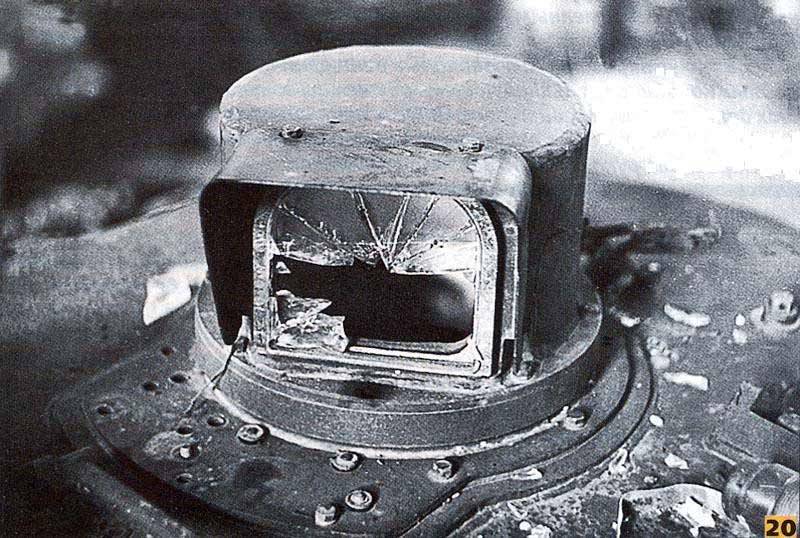
We are talking about optical surveillance and reconnaissance devices. What are the "eyes" of any modern armored vehicles? Exactly - prismatic observation devices and sights heads. But prisms in this case can be ignored, since it is practically impossible to conduct effective fire (and indeed battle) with their help. It should be noted that domestic Tanks surpass foreign survivability in terms of survivability, since the combined day-night panoramic sights for the gunner with a channel for the commander are not used with us (currently in service). The frontal projection area of their heads is smaller, the number is 1 piece larger, they practically do not protrude above the body and do not stand out sharply. Of course, visibility is lame, but it's better to see poorly than to see your last moments well.
It turns out that at one time even research was carried out on the issue of tank stability to fire 30 mm guns. Unbelievable, but true - a tank is easy to incapacitate with just a few hits. The main thing is that they are relatively accurate.
Returning to the usual small arms, it is worth noting that it can seriously harm the protection of the tank, even without incapacitating optical devices. Under such protection refers to the hinged dynamic protection (LDD). The relatively thin walls of the boxes of NDZ blocks cannot withstand even the usual bullets of assault rifles at close range. Blocks are deformed, dismantled (broken). Not even detonated explosive plates lose their effectiveness. But the NDT must survive to the use of the enemy RPG.
Conclusions were made by the designers - the built-in dynamic protection (VDZ) appeared, the outer layer of armor of which withstands small arms fire and keeps the dynamic protection blocks in good condition. Unfortunately, not all tanks in service with the Armed Forces of the Russian Federation, have undergone a modernization. Even more regrettable, the Airborne Troops are not applicable to domestic light armored vehicles currently in service. What to say about VDZ, if there are still problems with installing NDZ on it.
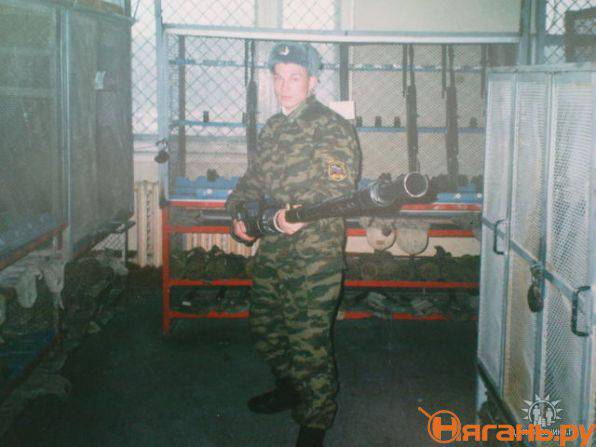
If you go to the problem from the other side, then in principle it can be assumed that most of the terrorists and militants of the illegal armed groups, with the exception of suicide bombers, want to live. Therefore, they are fighting for money, not for “thank you” and for the sake of the bright future of all mankind. Even with a large-caliber machine-gun or a rifle with armor-piercing cartridges that easily pierce armor BTR, BMP, BMD, no one in ambush in the next bushes from the column will not sit. The appearance of a fighter with CPV in his hands makes the unique “terminator” in the person of Arnold Schwarzenegger nervously smoking on the sidelines. But it’s scary to go into battle somehow, and dragging yourself over the far beyond 25 kg by weight is iron fun (not counting 11 kg 50-ti cartridges in a box), when you are attacked by fired and evil opponents, the pleasure is below average. In addition, unlike the BTR shooter, such a machine gunner is not protected at all. The only thing that he can cover up in case of failure is the range, which slowly but surely levels the parity of firepower over the armor.
Conclusion: domestic armored personnel carriers, infantry fighting vehicles, BMD provide adequate protection against conventional weapons when used as intended, that is, the armor protection of light armored vehicles protects against small-arms (light) weapons (conventional weapons).
2. The armor protection of domestic tanks, armored personnel carriers, infantry fighting vehicles and BMD does not protect against RPG fire (sometimes referred to as "simple", "obsolete").
This question is most often mentioned when talking about the experience of hostilities in Afghanistan (both the Soviet troops during the 1979-1989 period, and the NATO contingent from the 2001 year), two Chechen campaigns.
In the context of the Afghan war among the personnel of the infantry infantry units of the BTR undeservedly received the nickname of "tin". This fact was due to the weak protection of the BTR from RPG fire. Here we immediately recall the anti-bullet armor of the armored personnel carrier, infantry fighting vehicle, BMD, that these simplest and outdated RPG shots were developed at about the same time as the armored vehicles mentioned above, as well as that the armored personnel carrier, infantry fighting vehicle, and BMD are not tanks.
Technique determines the tactics of combat. During the war in Afghanistan, Soviet troops encountered the specific nature of the fighting in the mountain-desert terrain. Armored vehicles are not to blame. Similarly, the tactics of combat operations in the city, when infantry covers moving armored vehicles from the flanks (adjacent to the road), the infantry had to operate in the mountains. Certainly, it is impossible to “digest” on foot. For any forced savings you had to pay.
Each reporting period in that war made adjustments to the tactics of warfare, developed methods of movement of columns, ways to identify and overcome ambushes. And all these measures had the desired effect. The phrase "Afghan experience" is valid not only in relation to the aul cleanups. Unfortunately, experience was not taken into account in the first Chechen campaign ...
Again, after years of 12, the same Afghanistan entered the allied contingent led by the United States on new armored vehicles, including special vehicles protected from undermining MRAP mines, including with hinged screen screens. Have they got less loss? These measures did not lead to a drastic reduction in losses, especially in terms of protection against RPGs. Fortunately or again, unfortunately, the Soviet experience was not properly taken into account by the US military. A dismounted carriage from an exploded and immobilized MRAP was bombarded with small arms with impunity.
According to official data, everything looks beautiful, in comparison with the losses of the Soviet troops. Here is just one experience of the Desert Storm knows how minimally records of combat losses in the US Armed Forces (for example, soldiers who received radiation sickness were not entered in the lists of the wounded in combat actions, the loss of armored vehicles from “friendly” fire was taken into account only by journalists).
In addition to multiplying the magnitude of casualties by a figure no less than two, we will also take into account the nature of current hostilities. If the United States itself equipped the entire capitalist world for a battle with the Soviet troops, now the spirits are by themselves, while the weapons they have not changed in principle and have not been updated, and the number of allied forces is approximately equal to the number of personnel of the Soviet limited contingent.
Intermediate conclusion: in the conditions of the partisan war, all those who fall into ambushes are on an equal footing. For example, the Merkava in Lebanon burned equally well in both 1982 and 2006. Another interim conclusion: in the near future, not a single armed conflict, not to mention the war, will not do without the widespread use of armored vehicles: tanks, infantry fighting vehicles, and armored personnel carriers. Even in local conflicts, armored vehicles remain in demand as well-protected mobile firing points.
As already mentioned, RPGs and ATGMs are used covertly, from ambushes. Units in ambush position themselves in a manner convenient for themselves in order to inflict on the enemy the maximum possible harm profitably using the potential of the weaponry. But the partisan ambush is not full-scale hostilities with their battles. This is a “protest action” against the invaders, who use the seized territory, but do not attach it to themselves.
OBD using domestic armored vehicles is not only great at home. How did domestic armored personnel carriers and infantry fighting vehicles manifest themselves in battles?
In the war between Syria and Israel 1982, the Syrian army officers were pleased with the BMP-1. For example, a certain Syrian military officer M. Fauri was very pleased with the effectiveness of the BMP-1, on which he had to fight in person. During that war, he was the commander of an intelligence platoon. Fire 73-mm guns 2А28 "Thunder" his car were destroyed by two Israeli American-made armored personnel carriers M113A1, and by launching the Malyutka ATGM of the same BMP - tank М60А1. The very same BMP-1 remained intact until the end of the war. There is a complete implementation of the BMP assigned to it tasks: the fight against manpower, lightly armored vehicles and, if necessary, with enemy tanks, and even when acting on the front line.
The Iraqi forces in the 1980-1988 war against Iran also effectively used the BMP-1. Machines with troops at maximum speed jumped to the front edge of the enemy, immediately overcome the first trench and landed the infantry. She attacked the enemy in the first trench from the rear, destroying primarily anti-tank weapons. The tanks, which by then had crossed the first trench, approached without risk of getting a grenade from an RPG into the board or into the stern.
It has three major military conflicts at the same time, but in different theaters of war. Hilly desert terrain on the border of Syria and Israel, the mountain-desert terrain of Afghanistan, the flat desert terrain of Iraq and Iran. In the first and last, domestic light armored vehicles were massively and effectively used against their counterparts in combat. Here is the insidious trail of the nature of the fighting.
Armored vehicles were also massively used in Operation Desert Storm, where tanks, infantry fighting vehicles and armored personnel carriers of the US armed forces came together against domestic export samples (cut-down versions) of Iraq. The conflict is notable for the fact that despite the informational and logistical superiority of the US forces grouping over the Iraqi armed forces, the Yankees avoided open battles. At the same time, the Americans tried to bypass Iraqi tanks from the flanks and rear (according to Western sources - 75% of all hits had to their sides and stern).
In the course of Operation Freedom to Iraq, there were practically no open battles of armored vehicles of the two sides. Similar to the actions of dushmans against the Soviet troops in Afghanistan, the Iraqis preferred guerrilla actions. According to official figures, from 2003 to 2006 year. 20 Abrams tanks, 50 BMP M2A2 / M2AZ Bradley, 20 wheeled BMP Stryker, 250 multipurpose Hummer vehicles and more 500 different army trucks and cars were irretrievably lost in Iraq. Here it is worth adding the irretrievable loss of 85 helicopters, of which the majority are the Ap-X AN-64 type machines. But this is again “official data”. Needless to say about the Hummers 'crews' chances of surviving an RPG hit, making it impossible to recover?
By the way, looking a little ahead, I’ll add that on the roofs of the Hummers, who not long ago officially left the post of the main vehicle of the advancing infantry, it is forbidden for US troops to ride. The armored version of the Hummer was designed to protect against conventional weapons. Attention! A question for connoisseurs: “There are those who wish to change the BTR-80, BMD-1, BMP-1 to HMMWV M1097 (even the second or third generation)?” I think it’s full, but English-speaking.
Of course, not only the nature of hostilities causes differences in combat losses between conflicts. For example, during the first Chechen campaign that had become fundamental and relevant to the present, it was possible to avoid incidents of armored vehicles being destroyed in a more or less trained crew of vehicles (the most powerful land mines do not count). So, for example, in January 1995 of the tank T-72B No. 529 fired simultaneously several calculations of the militants armed with RPG-7 and LNG-9 grenade launchers. Skillfully maneuvering and firing from all types of weapons, the crew of the tank was able, ultimately, to destroy the grenade throwers and safely get out of battle. After this battle, on the hull and turret of the battle, seven hits of LNG and RPG grenades were counted, but the armor was not pierced. The crew managed not to substitute the onboard projections of the enemy and became the winner.
In the spring of 1996, the tank company of one of the rifle regiments took part in the liberation of the village of Gonskoye, which was defended by more than 400 well-armed militants. She was armed with T-72B tanks equipped with dynamic defenses. The tanks attacked motorized riflemen in combat formations from the line of transition to the attack, remote from the militants' positions on the 1200 m. During the attack, the enemy tried to repel it with anti-tank systems with 9М111 “Fagot” missiles. A total of 14 ATGM launches were made. Two missiles did not reach the target thanks to a maneuver skillfully conducted by the crew of the vehicle (both missiles were intended for the same tank). 12 missiles hit the tanks, and four missiles landed in one of the cars. However, on vehicles hit by an ATGM, there were relatively minor damage that did not lead to the loss of their combat capability, and dynamic protection elements also worked. The penetration of armor was achieved only in one machine as a result of the launch of the rocket “slide” and its penetration into the tower from above at an angle of 15-20 degrees around the gunner's hatch. As a result of the cumulative jet, the electrical wiring was damaged and one crew member was slightly injured. The tank retained its combat capability and, despite the fact that as a result of the damage to the wiring, the automatic loader failed, he continued to perform the task. After the battle, he was sent in for repair. On the remaining T-72B, only the triggered elements of dynamic protection were replaced.
Fire from tank guns ATGM launchers and their calculations were destroyed.
The familiar zampotekh tank regiment talked about the methods of "survival" of the obsolete T-62 (in modifications deprived of dynamic protection), and he did not teach the authoritative and "bad" anyone. Such "relict" tanks under the control of a well-coordinated crew, masters of their craft, managed rare scratches on the hull. Namely: while the gunner and loader performed the assigned fire mission, the driver-mechanic (to a lesser extent) and the tank commander watched the situation. Duplication of fire control on the T-62 was not implemented, but the commander’s control system allowed him to deploy the tower at the heading angle of the commander's periscope at the touch of a button. As soon as the commander intercepted the movement of the grenade launchers of an illegal armed formation or a shot from an RPG, an anti-missile launch, he pressed this button. The gunner could only quickly defuse the gun in the direction of rotation of the tower. From the power of the muzzle wave, rocket-propelled grenades simply blown away, or they changed the trajectory. Then the line of grenade launchers came under fire.
And here is an illustrated example of a very common breakup that exposed the sides of tanks (see picture 31). Of course, the flimsy mounts of bulwarks often lead to their loss by themselves. But how arrogant is enough to rely on the poor protection of tanks, when the crews, clinging to the walls of houses, themselves cut off the side screens and NDZ units? Technique in the hands of a savage is a pile of metal.
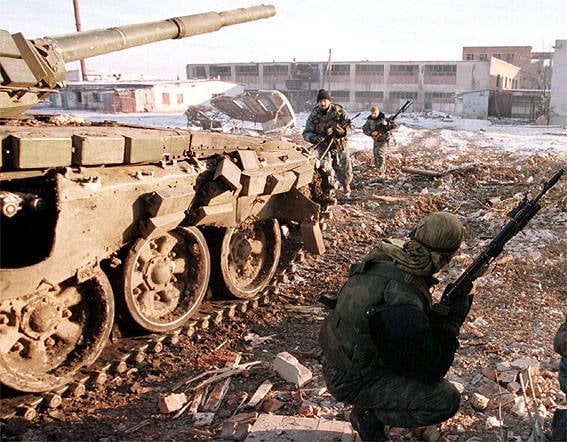
The final conclusion:
- in the case of illiterate (unqualified) actions of the crews, even the most advanced equipment is not capable of endlessly withstanding hits of anti-tank weapons, the evolutionary cycle of which is significantly ahead of the incubation cycle of protective equipment. Breaking is not building;
- BTR, BMP, BMD are not intended for independent action in conditions of mass use of anti-tank weapons by the enemy. In the course of many years of operation, this property of the BTR, BMP, BMD, embedded in them in the design, has been repeatedly confirmed;
- armor protection of domestic, as well as foreign armored personnel carriers, infantry fighting vehicles and BMD does not protect against RPG fire; At the same time, against tanks, protection against RPGs can be assessed as satisfactory.
3. Weak anti-mine resistance of domestic tanks, armored personnel carriers, infantry fighting vehicles and BMD forces the infantry to go on armor. This fear of fear overpowers the fear of death from a bullet. A significant increase in vehicle mass from additional anti-mine armor is acceptable.
I believe, first we need to resolve the issue of racial hostility of mines and armored vehicles, and then smoothly move on to the ailing frightening infantry on the roof.
Recently, it is considered that the obligatory requirement for modern tanks, armored personnel carriers and infantry fighting vehicles is high mine resistance. And is it really necessary or is it just a PR move imposed by Western armored vehicle manufacturers, always seeking to increase profits? Or are we really just “scored” and hopelessly behind?
So it happened at the behest of information warfare specialists that the losses from mines and IEDs were most likely to be agitated by immigrants from Europe in Africa, the experience of combat actions which resulted in the creation of armored vehicles resistant to mines - MRAP. The pioneer in the field of creating machines like MRAP (hereinafter referred to as MRAP) was Rhodesia, the successful idea was adopted by South Africa, the USA and others. Again, the MRAP was regarded only as an addition to the usual types of armored vehicles.
MRAPs are used for: infantry transportation in areas where illegal armed formations are active; transportation of high-ranking officials in conditions of increased terrorist danger; supplies of remote strong points and garrisons. At present, when most conflicts do not proceed as a clash of two regular armies, but as a coercion of partisans to peace, the role of the MRAP is becoming ever more relevant.
The transition from active hostilities of the Iraqi Armed Forces during the Desert Storm to partisan during the Freedom of Iraq forced the Pentagon to think first of all not about the durability of the frontal armor of its tanks against the old Soviet BPS, but about the protection of infantry vehicles from min. As a result, on an emergency basis, several MRAP samples from various manufacturers were launched into service. A total of about 20000 machines were purchased.
The main constructive measures to improve protection from the action of mines, implemented in MRAP:
1) maximum removal of the hull of the object to be protected (volume) from the road surface / mine blasting site (to reduce the impact and removal of blast energy from the hull);
2) giving the V-shaped part of the hull of the protected projection (in this case also airborne mines are considered);
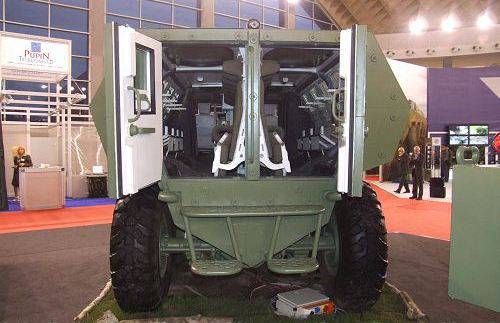
It is clear that the thickness of the armor plates of the V-shaped hull should be necessary and sufficient to withstand the detonation of a standard anti-tank mine under the vehicle (for example, the domestic TM-57 / TM-62 is 7-8 kg BB, M19 USA - 9,5 kg BB, by the way pure TNT Samples of the first years of release were being filled), while the rest of the armor was anti-bullet However, most MRAPs provide protection from VN with a power of 5-7 kg of TNT. Modern MRAP of the US Armed Forces are wheeled vehicles with a mass of 12 tons, a height above 2,6 m and a length of at least 5,9 m.
As soon as positive reviews of the operation of the MRAP appeared, a second wave of harsh criticism rolled into domestic armored vehicles, even more brutal. At the same time, it turned out that these results (exaggerated, to say the least) are expensive. Thus, the operation of only one US-based MRAP costs at least 10000 USD per year, and that is if repair was not required after the mine exploded. Currently, the United States does not really know what to do with its MRAP. Not believing the author for the word: (http://www.army-guide.com/rus/article/article.php?forumID=2119).
Having created armored vehicles with enhanced protection from the effect of mines for a certain theater and the nature of the hostilities, they cannot decide on their place and the need for the presence of army armored vehicles in the hierarchy. Well, the Pentagon cannot define their tasks in conditions of general combat. And these miracles of technology were spanked more than the BTR-80 for the whole USSR. Well, a little was transferred to Afghanistan, a little mothballed just in case, they sold a bit. But bad luck - it's time to change the main vehicle of the US Armed Forces HMMWV, and the project JLTV in the number of 50000 units is intended to change it. JLTV has a requirement to ensure the crew’s safety from the effects of mines and IEDs at a level not lower than MRAP, but at a much lower weight and operating costs. So far, there has not been much superiority over MRAP in JLTV prototypes. Oshkosh Truck's M-ATV is generally one in two. The initiative has fallen in love with the initiator in full. But those who do not know about these problems have achieved the cessation of deliveries of domestic armored vehicles to the troops and continue to wipe their pants with a sense of accomplishment, instead of tactilely trying out this very technique.
Now about the obvious advantages and disadvantages of the MRAP. The majority of manufacturers of MRAP claimed protection against explosion, with a capacity of 5-7 kg of TNT equivalent, which is clearly not enough, for example, to protect against the TM-62 mine. Moreover, most of these machines have a wheel formula 4х4. Undermining even the most powerful IEDs or mines (while cases of anti-tracked mines and similar IEDs are being considered), leading to the failure of one wheel, do not allow movement to continue. That is, after the explosion, the car will remain in the zone of fire. And the surviving crew will have to risk their lives again. We recall about the features of ambushes, bulletproof armor and we understand that a radical reduction in losses is not to be expected. And if the partisans will have a “shaitan-pipe” (RPG-7) ...
At the same time, the wheel formula 8х8, used in Soviet BTR (equal in mass to the MRAP of the first, lightest level), allowed the car to continue driving even after losing four wheels (two wheels on one side). The crew and landing force remained intact, since the main shock wave from the explosion passed under the bottom and was led away from the hull. Therefore, the Afghan Mujahideen used up to 35 kg of TNT for guaranteed undermining of the Soviet BTR. For example, the machine shown in the 33 image left the scene of the blast on its own (the picture was taken in 10 km from the blast site). People inside the car received light and medium contusion injuries. Outside on the armor, two soldiers were killed (spinal fracture and head injury). Restoration of the car in the repair company regiment took 24 hours.
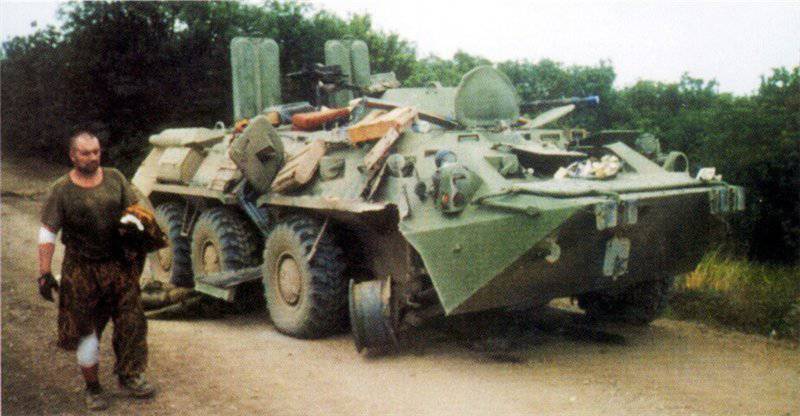
But the BMD and BMP, on the contrary, showed weak mine resistance. When an anti-mine mine was detonated or a mine was used, everyone inside the vehicle received serious injuries or died, not to mention the loss of mobility. Unfortunately, this is the specificity of light tracked vehicles.
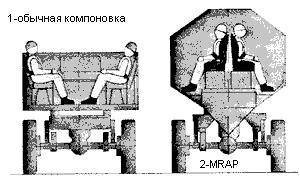
The overestimated ground clearance theoretically helps to dissipate the blast wave during a blast, but its magnitude in 355-450 mm for MRAP machines does not exceed the performance of domestic armored vehicles (In BTR-80, the clearance is 475 mm). The maximum removal of the hull from the road surface, as well as giving a V-shaped bottom, increases the height of the armored vehicle. For fighting in the city, this will not lead to a significant reduction in its visibility. But when attacking actions outside settlements, a high silhouette with a clear clearance under the bottom will seriously facilitate the enemy's task of detecting a target. And despite the fact that special attention has recently been paid to means of reducing visibility (stealth technology, due to which all developed armored vehicles are “squares”). What is the use of them, except for the utilization of funds, if the dimensions of such machines visually unmask them at long distances and make them targets that are convenient for destruction with hand-held anti-tank weapons and large-caliber small arms?
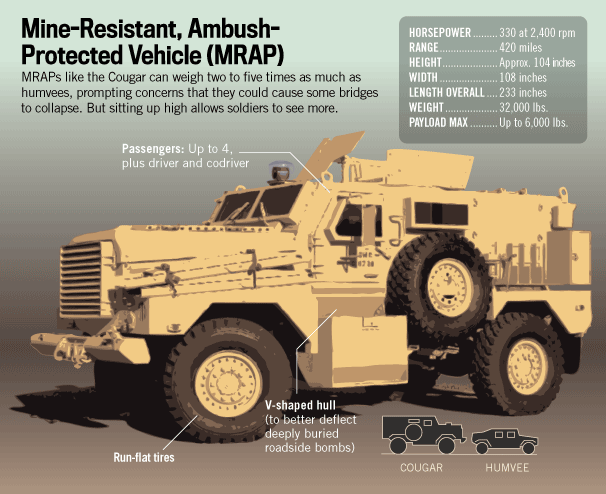
Not everything is unambiguously with the superiority of the V-shaped bottom in the fight against antidot and anti-tracked mines. If, in the fight with the first, the V-shaped bottom is the optimal solution, then with the second, the V-shaped form is rather a “disservice” for the mine.
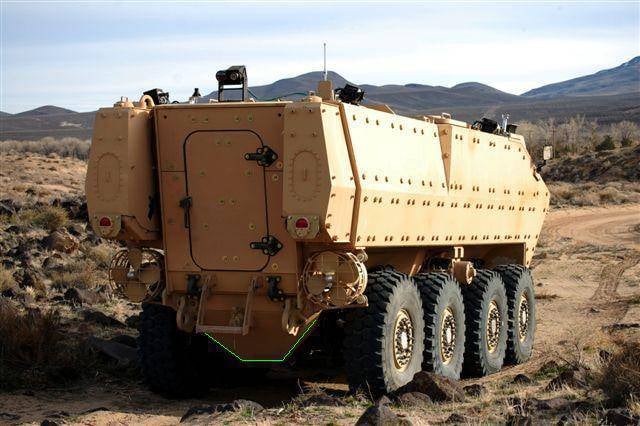
Figure 37 illustrates the advantage in dissipating the energy of an explosion of a V-shaped bottom over a flat one when it explodes on an anti-tracked mine. The author of the picture miraculously bent the arrow imitating a shock wave, which was stuck into it at a right angle in the center of the right side. If the flat bottom doesn’t withstand the impact (just by the angle), can the V-shaped energy dissipate the explosion energy?
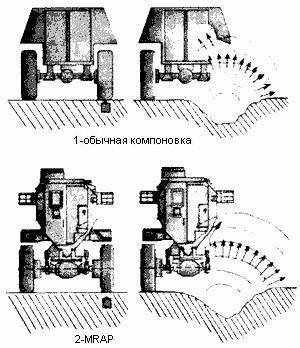
Let's skip high-explosive anti-bottom mines and recall right away their cumulative counterparts, from which an increase in ground clearance of 100 mm and a relative increase in bottom armor thickness from its V-shaped slope will not play a significant role in enhancing protection. When the focal length is reached - "godfather" will work on the armor in full. From the bottom, there will be no interference with the normal formation of a cumulative jet. For example, PG-7B jet shots have a mass of explosives from a 716 warhead. Everyone already knows the penetration ability. The mines have a caliber, that the mass of explosives have great potential for rapid development, and the benchmark PG-7В for them is not an exorbitant limit.
In the "network" there is such a curious material (http://www.liveleak.com/view?i=ada_1189106198), where the method and the result of using the order of the anti-tank grenades RKG-3, which are forgotten and not described in the first part of the article, are given. What can we say about anti-skid and anti-slip mines? Neither sides nor roof developed V-shaped. Yes, the proliferation of this type of mines is not great, especially among the partisans, but what prevents in the light of newly discovered circumstances to recall them?
It was the turn of radio-controlled land mines. They are usually undermined when the least protected part of the hull is located above the mine (or the location of the landing force, crew, ammunition, which can be detonated). Here is the overwhelming advantage of MRAP protection. It would have seemed a victory, but ... We compare the release of IEDs and radio-controlled mines with the number of conventional anti-tank mines released and produced, and we understand that it is more worth being afraid of the latter, especially if you don’t have to fight with partisans.
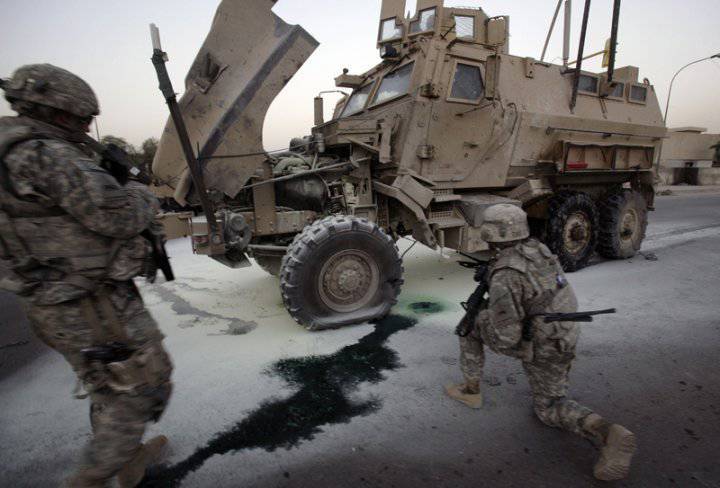
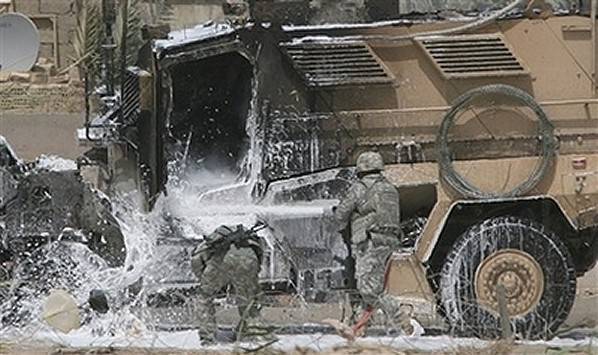
Most MRAPs are based on front-wheel commercially available trucks for cost reduction. Engine compartments, as a rule, are not booked at all (see figures 31, 32). Well, withstand twelve-ton MRAP blasting on a mine in TNT equivalent 6-8 kg. The armor protection of the sides, roof, stern and MTO from this did not become opposable. What is there RPG and NSVT - even less powerful small arms will easily deal with them. Benefit on top of that, this defense has almost no tilt angles that contribute to the ricocheting of grenades, shells and bullets. It is not difficult to deprive the MRAP of mobility even from light weapons, which, however, does not serve as a reason for their criticism.
Many manufacturers of armored vehicles, developing their MRAP "from scratch" or upgrading the equipment already produced, are still limited to the phrase "V-shaped bottom." For example, the “Stryker” Double V-Hull, which already has two V-shaped bottoms, but gives due protection to the sides. By the way, despite complaints about the lack of protection against partisan actions, the "hawkers of democracy" were satisfied with the fighting qualities of the Stryker, and once again convinced themselves of the correctness of the Stryker brigade strategy, which is a direct analogue to our good old SME on the BTR. The developers of “DINGO ATF” did use the traditional flat bottom.
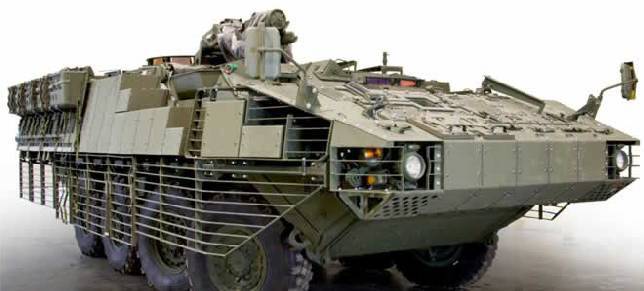
The power of the MRAP is not enough even for adequate defense. Modules are poorly protected from the action of even light weapons. All for the sake of weight loss, because the cost of delivering one MRAP from the USA to Iraq is a pleasure with at least four digits in the bill. Iraq is certainly not space, but those extra pounds are also costly, especially when they are among thousands of pieces of equipment.
In Russia, designers, driven by a wave of criticism, under the pressure of military leaders with imposed opinion, also rushed to create armored vehicles of a new generation, with the mandatory requirement of protection from mines, like in MRAP. And this is true for light and heavy developed armored vehicles. But it is worth thinking about the following question: “Who are we going to seize?” Russia has no territorial claims to any country. If anyone threatens to be undermined by mines, it is to damned enemies who are overcoming the immense fields of our great homeland, well-sown with engineering ammunition, the production of which can be mastered by almost everyone in the home kitchen. Why do we need thousands of MRAP? Why waste so much extra “iron” on the bottom when they can cover the board (see picture 43)?
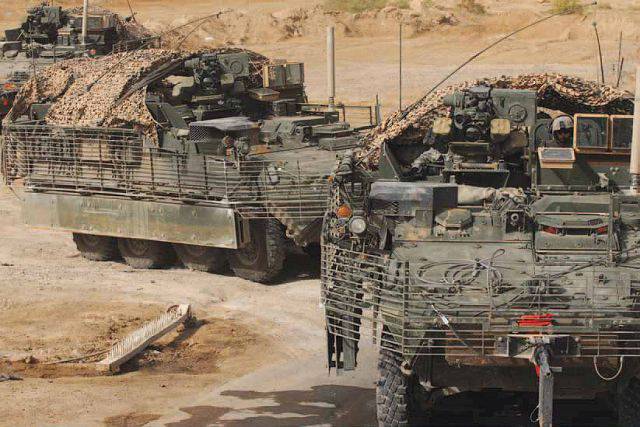
Probably, it is worth developing a technique with enhanced mine protection, but only within the framework of creating special machines - the BIS. The analysts of the US Armed Forces themselves fully agreed with this, as it became known from recent Western publications. In addition to the MNR M1 Grizzly (adopted, there is no information about entering the troops) for the army we developed an analogue of our BIS and UR-77 - BIS ABV (Assault Breacher Vehicle), note - it is “assault”. This unification, and standardization, and savings, and increased protection from all sides.
Once again we ask the question: "Is it necessary to ensure the defense of the mines by strengthening the bottom and creating new vehicles of armored vehicles?"
In the first part of the article, it was already mentioned about mines, which are divided according to the fuse target sensor according to the following types: pressure, discharge, tension, break, inertial, wind, magnetic, acoustic, electromagnetic, optical, temperature and barometric action. Virtually all such mines are efficiently handled by engineering equipment specially developed for these purposes, which was also mentioned.
Currently, there are four main ways of making passages in minefields: mechanical, explosive, non-contact and manual. The latter is clearly of little interest.
In the mechanical method of making passages in minefields, mounted (built-in) devices are used that are mounted in front of the armored vehicle (roller and roller-and-knife trawls KMT-6, KMT-7, KMT-8, KMT-10) or armored clearance machines BMR .
The explosive method of making passages in minefields involves the use of demining charges, undermining which the mines operate, collapse and are thrown out of the passage being made (demining installations UR-77, UR-83П).
The non-contact method is used to trigger mines that have non-contact target sensors or disable electronic components of fuses (EMT electromagnetic trawl, Infauna, Centaur station, RP-377BM, Lesochek, and others).
This non-contact method is the most promising (in the opinion of the author). The cost of equipment is incomparably higher than the cost of armor, but the equipment will eliminate the effect of an explosion on the carrier, while the armor will take a hit on itself, and in the best case will be replaced with a new one. At worst, even if the crew is alive and well, the car is not recoverable. In the column it will be enough to have one machine with the equipment, while the MRAP will be able to detect a mine only after the explosion. The cost of one MRAP on average 350-400 thousand USD. Is it really more expensive special means?
When conducting an attacking battle, making passes in enemy minefields is carried out, as a rule, in an explosive manner using extended charges (US) and demining installations of the type UR-77. Tanks and infantry fighting vehicles (BMP), equipped with trawls, overcome barriers on their own. Doesn't it seem that equipping light armored vehicles with a sufficient number of trawls for overcoming sections of a mined area is much more efficient, cheaper in production and operation? Installation of electronic equipment for just one car from the column is even more efficient, cheaper in production and operation? The USSR had trawls even before the events in Afghanistan. Rhodesia and the United States did not have them, so they went their own way, which is now being dragged along by everyone, including Russia. But the US has enough time to remember it enough - now even trawls are fitted to MRAP-adapted minefield fields.
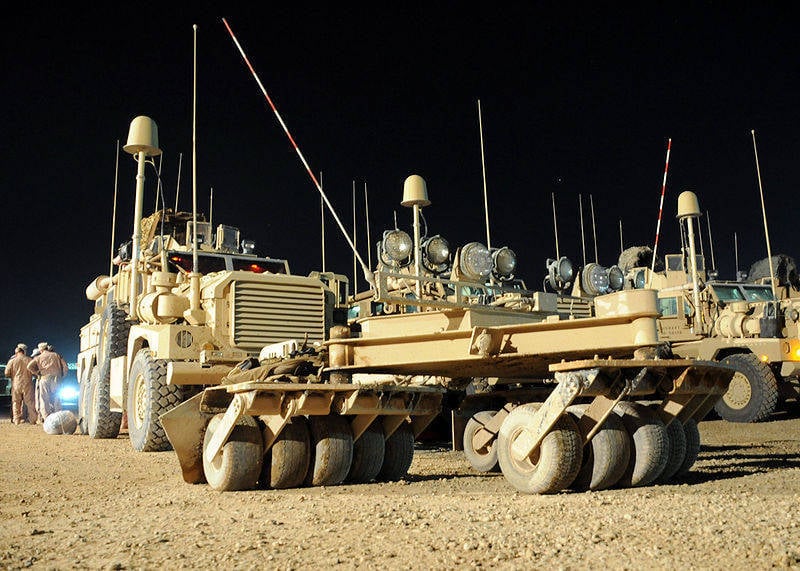
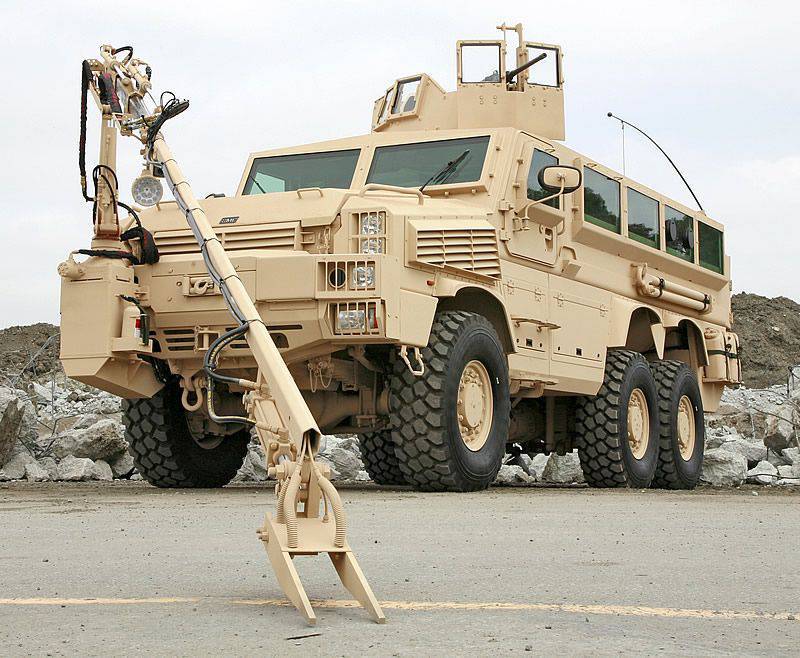
Under the conditions of an interested industry, mines have enormous potential for modernization. The author is inclined to believe that it is possible to create anti-tank mines with tandem combat units with armor penetration characteristics not inferior to rocket-propelled grenades. And then what? Give 200 mm armor on the bottom!? Another obvious huge evolutionary parity of the means of destruction over the armor.
Hack and predictor Aviator:
- guerrilla actions from ambush inevitably lead to damage. Even having a special MRAP machine in its fleet, an allied NATO contingent suffers losses from the action of mines;
- in fact, the whole range of measures to improve protection, implemented in the MRAP, protects only against anti-explosive high explosive devices and it’s not a fact that it is against anti-tank mines, industrial production, especially modern ones;
- MRAP is just an additional type of armored vehicles. Moreover, it is not intended to drive through minefields, but is intended only to increase the survivability of the crew in the event of a mine explosion or an IED. Consequently, it is expedient to implement the concept of MRAP not within the framework of a new class of armored vehicles, but as part of the modernization of the part in service and mass-produced BTR, BMP and BMD (just in case);
- according to the method of protection from the action of mines, the MRAPs are merely a perverted analog of the roller trawl;
- in conditions of general combat, increased protection from the action of mines is necessary only for a special type of vehicle, and therefore, domestic light armor meets its purpose and the modern requirements of combat;
- the availability of modern radio-electronic means allows for equipping domestic tanks, armored personnel carriers, infantry fighting vehicles and BMD with them to achieve the required level of protection against the action of mines, moreover, at a radically top level of protection against mines (remote), unlike foreign analogues. Unfortunately, it seems that, as always, Russia will have to go from the pioneers to the overtakers.
The queue of recognition of symptoms and the search for pathogens of Fear.
I would like to note in advance that it seems doubtful that the soldiers of the United States or any other country are not afraid of mines, moving in the cabins of their MRAP or Hummery. Mines in the passport do not look, the purpose of the visit or a military ID is not asked. So does the transportation of the landing on the roof, and not inside the troop compartment, increase security from the action of mines?
Indeed, every person who observed Soviet / Russian soldiers and officers sitting on the roofs of an armored troop-carrier, BMD, and infantry fighting vehicles had the question: “Why not inside?”. “When a mine is blown up, only the crew will die, and not the entire squad,” the response of enlightened neighbors or screen heroes sounded pathetic. Who and when first voiced this explanation, came up with this style of movement is not known.
But it is known that the militants of the illegal armed groups used this very well - why waste an RPG shot or put a mine when you can just give a line from the window of the machine gun and put a branch on without looking, and the car will go on without noticing the loss. Laid a mine two meters from the road, and yes even poured nails on top. Ba-bang - and the board was cleared of infantry. Remember history Figure 33 and understand that guaranteed to get rid of losses, this measure does not help. Yes, it is generally nothing in such situations will not help. But a logical explanation for riding on the roof is simply bound to exist!
The height of the Russian BTR-80 is 2460 mm (on the roof of the tower), 475 mm clearance, the French VBCI is 2260 mm (the value is clearly underestimated, the height of the tower is not taken into account), the clearance is 500 mm. But if the BTR-80 has inclined side plates, then the VBCI is straight. Naturally, no one will jump from such a height of desire. The one who did not jump from the body of an army KAMAZ in a standard fifteen-kilogram outfit with a gun in his hands, would hardly believe that from such a height it is possible to break into a cake. The answer is short - you can, because it is not for nothing that the paratroopers are taught to “stack” when landing. The situation is very similar. So, in the event of a mine exploding, the landing troops that had fallen off from the roof would hardly be combat-ready. There can be no reduction in speech overloads - vertebrae sitting on the roof will receive exactly the same amount as they would receive sitting inside.
Maybe the fact is that when armor is broken through with an RPG shot, the crew in the car will receive barotrauma will be broken off? But the grenade explodes outside. First, the action of the fragments of the hull and the products of the explosion will be tested just sitting on top.
A reasonable explanation is only one thing - the lack of ergonomics. At the disposal of the landing force in BMD-1 (2) there is no more than 1300 mm of free space (vehicle height minus clearance and height of the tower, without taking into account the thickness of the roof, bottom, etc.), at the disposal of the infantry in BPM-1 (2) - 1330 mm. That is, the landing sits in them in the positions of the embryo, which is not entirely comfortable (see picture 50). All domestic armored vehicles do not have air conditioners, and being inside a "pan", in which the air temperature easily reaches 60 оС, to put it mildly, does not contribute to an increase in combat readiness. Doorways are small, it is impossible to dismount quickly and not to stuff the cones, and even that is “fast” far to “satisfactory” (13-15 seconds).
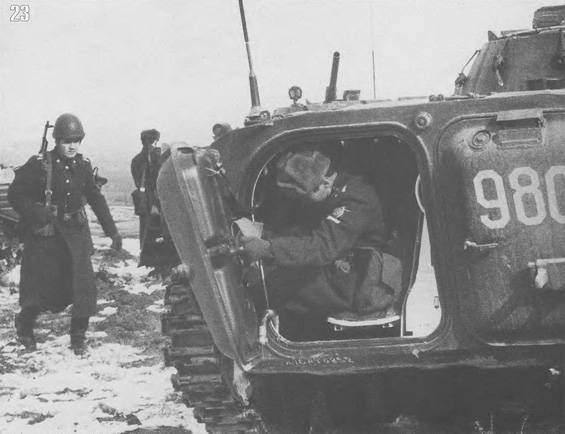
At the beginning of the shelling or undermining of a mine, as well as the beginning of a fire in a car, it will be incomparably more difficult for wounded soldiers to get out (dismount) from it than from it. The local conflict is still not Stalingrad. Round-the-clock fighting by partisans is rarely conducted, and sensible military, as we know from the first part of the article, do not climb on the APC to attack, just as they don’t take a taxi to the bakery.
Fear of dying from mines is more comparable with the same fear of movement in the forest: it seems to the incoming one that the enemy sits behind each tree or shrub and aims at it, and the defender, on the contrary, that because of each tree, enemies are about to trample on him. And, of course, the peculiarities of the mentality - Russian "maybe", Ponte and recklessness. Here, in order not to be torn apart by the God-fearing Russian people, the author subtly hints that it was not by chance that he wrote a little earlier how the crew of the armored car might not notice the loss, but proceeded from the experiments of military operations in Chechnya.
Generally, based on the wide range of special engineering equipment and equipment in service with the Armed Forces of the Russian Federation (KMT, BIS, IMR, BREM, UR and others), created and intended to overcome engineering barriers, the need for mine protection from domestic light armored vehicles becomes, to put it, using normative vocabulary, inappropriate. Only the question of the presence of its necessary quantity in the troops remains open.
"Out of sight, out of mind". MRAP media star, where there is the BIS, WRI, BREM and SD, especially domestic. This is the only way to explain the unfair disregard for even the very existence of the best-in-class Russian engineering armored vehicles in favor of foreign convulsive attempts to create something similar.
Hack and predictor Aviator:
- go on the roof of the armored personnel carrier, infantry fighting vehicle, BMD is no safer than making a campaign for the crew inside the car, than moving around in the back of a truck with a canvas awning, and it is more expedient only from the point of view of the speed of leaving the vehicle (dismounting) in the event of an ambush attack on the convoy ;
- those properties of domestic armored vehicles that are described as shortcomings in comparison with modern models of armored vehicles of potential opponents are not such. A complete non-compliance with the requirements of protection, especially from the action of mines, is just bloated PR;
- in the Armed Forces of the Russian Federation there are no sufficient number of special vehicles BIS, WRI, protected from the action of mines similarly (honestly, an order of magnitude higher) MRAP, the functions of which were assigned to light armored vehicles that are not equipped with special engineering equipment in the form of mine trawls, which led to loss of personnel and equipment;
- the weak resistance of the domestic tanks, armored personnel carriers, infantry fighting vehicles and BMD, is not the factor that makes the infantry go on armor;
- for effective protection from the action of mines of domestic armored personnel carriers in combat, a special engineering technique was created, which should operate in a uniform manner with the same type chassis (MBT, BMP, BTR, BMD).
4. The armor protection of domestic armored personnel carriers, infantry fighting vehicles, BMD does not allow them to operate in conjunction with tanks.
Using or, as the lawyers say, on the basis of the first part of the article, we boldly cut off BMD and BTR from tanks. It remains to consider one person involved in the case - the BMP. If she doesn’t write “because of what and why” for a long time, she (they) has reached such a life, then we can note one very simple and objective argument. The following argument - from the fire of modern tank 120 / 125-mm cannons, even from long distances, does not always save the armor of modern main tanks. If, as usual, to turn around to foreign experience, it is clear that for some reason in the west they did not weld 150-mm sheets onto the front armor of the BMP, say, Bradley, which in the “Bure in the Desert” moved in the rear of the M1, surely hitting them in Stern "friendly" fire. It still does not help. By the way, the same VBCI must act in the same order as the Leclerc and is also deprived of a heavy armor.
In the light of the tendencies of transition to the caliber 140 mm, it seems more appropriate for the author to completely remove the task of operating with tanks in a general manner in an explicit manner, as it was provided for by TO and IE 1972 of the year.
The conclusion is obvious:
- it is possible to operate effectively with tanks even on a bicycle, but on what to act against tanks against tanks is another matter;
- Any tanker who chooses a target between a tank and a BMP to destroy, will first of all choose a tank, since it is the tank that carries enough firepower to defeat his counterpart. After that, you can safely deal with the BMP and its troops, you can even move off to a safe distance from its fire;
- the crew and the landing on the BMP to act against the tanks is no more dangerous than to act against them on foot;
- armor protection of domestic armored personnel carriers, infantry fighting vehicles, BMD allows them to act with tanks, but their use in actions against tanks is obviously associated with large losses.
5. The system of active protection "Arena" could significantly increase the security of armored personnel carriers, why is it still not installed?
Firstly: active protection systems (all domestic similar systems are called SAZ, foreign ones - “Hard kill APS”) are able to effectively deal only with cumulative ammunition, and for the most part with anti-tank guided missiles and rocket grenades. It will be more difficult to cope with thick tanker “kuma” hulls. And with the assertiveness of OFS, especially in variant G (concrete-piercing projectile), and the impetuous arrogance of BPS, it is possible to understand only in words, that is, theoretically.
But if you imagine the conditions of guerrilla warfare in urban environments and discard the empty arguments of interested representatives of RPG manufacturers (due to the nature of the duty ratio, which is a little further, it is proposed to hit the armored vehicles with SAZ with two simultaneous shots from different directions or from one, but with a slight delay) , then SAZ become extremely curious.
Secondly: except for Israel (there is information about the interest of India) in the issue of arming such systems, the armed forces of all developed countries are plagued by vague doubts. On the one hand, everything is great, but on the other, something stops. It is interesting, what makes constantly modernize the SAZ developed and ready for mass production? Need to understand ...
Main characteristics of SAZ:
- cost. Makes up 200 – 600 thousand USD (“Arena” - about 300 thousand USD);
- the mass of the set of equipment. It is 140 – 780 kg (“Arena” - 1100 kg);
- reaction time (from target detection to its defeat). Range: 0,005 – 0,560 sec (“Arena” - 0,070 sec);
- reaction time to the next target (that is the duty ratio). Range: 0,0 – 15,0 sec (“Arena” - 0,2 – 0,4 sec);
- the zone of the beginning of the detection of a dangerous target. Makes up 2 – 150 m (“Arena” - 50 m);
- zone of continuous defeat (“Arena” - 30 m);
- The number of warheads. Ammunition: 6 – 12 units ("Arena" - 22 units.);
- speed of targets being destroyed (“Arena” - 70 – 700 m / s);
- energy consumption (“Arena” - 1 kW);
- occupied reserved volume of the carrier (“Arena” - 30 l);
- protection sector in azimuth. Range: 150 – 360о (“Arena” - 270о);
- overlapping sectors of neighboring warheads. In one direction can operate from 1 to 16 blocks (that is, all).
It can be seen that the cost of one SAZ is comparable to the cost of one MRAP. At the same time, an important requirement for placing a SAZ on a carrier is its partial or complete location on top of all other protection systems. That is, SAZ is not only protected from small arms fire, but also interferes with the optimal location of other protection systems. Also, in most cases SAZ increase the visibility of the carrier. The enemy’s location of the blocks is known and visually visible, and he has the time and opportunity to take advantage of this or to inflict elementary damage by shooting SAZ.
Thirdly: alas, but despite the active advertising of the Arena and the primacy in the development and creation of SAZ, the most advanced, albeit later developed, are foreign samples. The Russian model Arena-E (Design Bureau of KBM, Kolomna) lost, as did Iron Fist (Israel Military Industries), Trophy (RAFAEL ADS), Quick Kill (Raytheon), AMAP-ADS (Deisenroth Engineering) by test results in India by the Swedish LEDS-150 (Saab). Yes, it can be said that this is an export option, but even purely according to the “Arena” performance characteristics in this list, the leaders are “from the end”, despite the fact that Saab is constantly rebuilding LEDS.
Fourthly: SAZ are effective against partisans, but they are in no way adapted to “normal” combat operations, that is, to frontal attacks. Not for nothing are SAZ warheads located closer to the sides and aft.
Fifth: a direct competitor in the face of the latest generation of mounted dynamic protection (NDZ) is much cheaper than a SAS in terms of cost with relatively equal efficiency (SAS can hit several targets released at the same point, but the protection area in azimuth and elevation and overall the number of NDZ blocks is much greater). In addition, to improve the protection of the carrier from RPG grenades, against which SAZ and NDZ are mainly targeted, and SAZ hopelessly lose to the simplest, most advanced, cheap and effective means - lattice screens. If SAZ does not expand the range of effectively struck ammunition, their prospects are unenviable.
Sixthly: on all demonstrative firing at the object protected by the Arena, it uses inert shots PG-2. That is, even manufacturers themselves do not believe in stopudovy efficiency and reliability of SAZ.
Hack and predictor Aviator:
- the idea of SAZ is quite attractive, but even today it is still “raw” for the needs of the consumer;
- the characteristics of the domestic SAZ “Arena” are inferior in many respects to their foreign counterparts (the analogue of the LEDS-300 being developed is not expected at all) and does not allow the commercially available passive protection systems of similar designation to surpass;
- The Arena SAZ is rightly ignored by the Armed Forces of the Russian Federation, but this does not remove the blame from the RF Ministry of Defense in particular for not equipping the domestic light armor with similar passive means of protection, unlike foreign armies.
6. Ammunition of domestic tanks is located in the hull, prone to detonation when a tank is detonated by a mine, unlike, for example, the M1 tank and its modifications.
With this question too it is not necessary to deal long. We go to learn materiel. We learn that tanks МХNUMX, starting with modification М1А1, have shells of three readiness queues. 1 shells are located in the housing niche under the tower, the rest in two niches in the tower in equal parts. 6-mm armored bulkheads are separated from the crew compartment. That is, when undermining a mine, the M20 also has something to detonate. One shot will explode or twenty-one significant role in the fate of the crew will not play.
But the mechanic-driver of the M1 tank is immured from the entire crew in his personal "office", and this is not sarcasm or irony. On the one hand, this increases the survivability of the crew. On the other hand, if, after an explosion in the fighting compartment, or simply after getting into the tower, the power system is stuck or the power system fails, then the mechanics will have to hope that the support will be close and will have time. After all, even if he can open the hatch, then squeeze between the hatch and the tower (cannon) - for nothing in the world. Then there is a choice either to burn, either to the mercy or to be torn apart by the enemy.
If you compare the M1 with domestic tanks, then immediately comes to mind the story of the battleship "Invincible" of the British Navy, in which the propelling charges were not protected by shells. Indeed, the shells and charges to them in burning cartridges placed in non-mechanized laying, domestic tanks are less protected than those placed in the trays of conveyors AZ / MH or sleeves laying МХNUMX. But, as it turned out in the practice of fighting, the protective shutters of the niches M1 tankers rarely close because of the inconvenience of the latter. Accordingly, in the case of detonation of ammunition, the crew members in the fighting compartment of the tank are not protected by anything. The crews of the T-1 and T-72 in similar conditions replenished ammunition only the number of mechanized shots. Shots placed in non-mechanized laying, remained in the boxes on the base, too, because of the inconvenience with their loading into the tank and subsequent use. Thus, in combat, T-80, T-72 were disposed of in part of their shortcomings, while the M80 got rid of its merits.
But still, a lower location to the tank floor, and therefore to the action of a mine explosion, in domestic tanks increases the likelihood of a detonation of ammunition, which has been repeatedly proved by OBD. At the same time, even the most defended OBD ammunition also detonated.
In the continuation of the comparison, another fact comes to mind - the confident infliction of contusion injuries and the disabling of the crew of the tank with the penetration of the CFC without penetration. It is still doubtful that the increase in survivability and security of the crew during the detonation of ammunition in an isolated compartment (tower niche) seems to be. Not only does the tank lose its ammunition and firepower and turns into a target, so the energy of the explosion in comparison with the outboard explosion of the CFS will be more. 20-mm wall as a damper, and the role of irresistible protection is weak. Again, getting into a shot placed in the turret is much simpler than a shot being in the conveyor inside the fighting compartment - the most protected place in the tank. Therefore, the design decision on the non-insulated placement of ammunition in the presence of a carousel AZ / MH was justified.
Disappointing for the crew, but a positive fact from the point of view of the possibility of restoring a domestic car is that if a charge placed in the hull is defeated, its burnout is more likely than detonation. The rest of the ammunition can remain completely unharmed, which is excluded when unitary loading.
Conclusion: in the event of a mine explosion, the ammunition sets of foreign tanks are prone to detonation to a lesser extent, compared to domestic ones. At the same time, in any real combat conditions, without the use of anti-tank mines or when tanks are equipped with mounted or attached mine defenses, the advantage in defending ammunition is unequivocally from domestic tanks.
7. Domestic armored vehicles have advanced to date optical-electronic means of dealing with the WTO. WTO will be the main means of destruction of tanks in the near future.
It is believed that to combat the WTO (precision weapons) armored vehicles need the following: means of reducing visibility for optical and electronic means of reconnaissance of targets, SAZ (EW equipment and so on).
If foreign armies already use on their combat vehicles means of reducing visibility (screens with a special coating and camouflage), the Russian Armed Forces in the old manner are masked manually by soldiers with brushes in their hands and a can of available paint and a pair of tied branches. Further exhibition samples dressed in shaggy rubber mats matter still can not move.
SAZ data are not intended for destroying enemy ammunition, but for counteracting their normal functioning - withdrawal from the optimal trajectory, redirecting to false targets and setting these false targets, blocking radio commands and radio interference. In the west, such SAZs are called “Soft kill APS”, domestic ones are optical-electronic countermeasure complexes (CEP).
In order to understand what and how armored vehicles will have to encounter with the CoE in the present and near future, we will get to know the specifics of using the WTO (guided artillery shells [UAS] and ATGM) in tanks.
1) An advanced observer with a set of equipment "honorary suicide bomber" consisting of a laser pointer-rangefinder, communications, orientation tools (GPS navigators, digital compasses, and so on), shot timing equipment scans the target.
More details about this kit: domestic LCD-4 costs more than 4 million rubles, weight - from 20,5 kg (the manufacturer has very tactfully kept silent that this is complete with a night vision unit and a thermal imager on 4 hours of operation, I want more - add a few thousand rubles and kg for the battery and for the thermal imager cooling unit); communications costs about 150 thousand rubles. with a mass of about 4,5 kg. Other "rubbish" also adds kilograms and rubles to the "piggy bank" of intelligence officers, and this is without taking into account personal weapons and standard equipment. And this is only one post, so each shot of the WTO literally goes gold and is simply obliged to do its “work” to “excellent”;
- after completing the topographic location, determining the coordinates and parameters of the target, he transfers the data to the battery commander (the senior officer of the battery if CMR are used);
- after calculating the initial shooting settings, the battery commander "gives the nod" to the shot. The matter is taken equipment synchronization shot, which will tell the scouts when to highlight the target;
- shot. UAS is coming to the trajectory section where the head of guidance starts searching for a target (descending branch of the trajectory). The Scout highlights the target;
- UAS, accepting the signal reflected from the target, corrects the flight path and hits the target.
It seems simple. What really? If we reject such “rare” weather troubles as fog, rain, snow, dust and sandstorms, low clouds and so on, come to terms with the fact that a goal can simply disappear from view, for example, by standing in bushes or behind a tree, drove into pit then stay with the following. The average time of flight of the projectile at a distance of over 20 km about 40 seconds. Of these, the required target illumination time for capturing it with a pointing head is no more than 15 seconds. Thus, the tank after its detection by the enemy's scout has about 60 seconds in order to avoid defeat, not counting the time spent on calculating installations, preparing and loading the shot, and exchanging radio data.
A little earlier, advanced observers called death row. This is because even at the present time, when the means of detecting laser irradiation and radio suppression stations on armored vehicles have not yet become widespread, experts agree that the WTO in its modern view will be effective only against the “backward” adversary. Possessing modern weapons, the enemy will easily find the scouts, and will bring their weapons on them - from a powerful laser emitter, a blinding observer (by the way, the Chinese are following this way) to a tank anti-tank system. Paradoxically, but the fact is that Lebanese militants who are actively using outdated Malyutka anti-tank guided missiles, are controlled by wire, in terms of security of WTO use, the most advanced.
Many “experts” will say that the return laser beam is nonsense, but the illegal armed formation snipers with the retarded glued eye from a distance of about 5000 m will not agree with the range finders of our artillery spotters. As well as the burned-out tubes of tank sights reconciliation when the distance measurement button is erroneously pressed when carrying out the maintenance of the TMS of tanks. Well, dozens of antisniper devices developed to date allow determining the source of exposure.
The cost of a WTO (guided artillery ammunition [UAB] and corrected artillery ammunition and aviation bombs [KAB]) exceeds the cost of an ATGM, and the cost of their combat use ... If a tank hits forward observers, then the WTO turns into an empty hefty suitcase, which is hard to drag along, but it is a pity to leave.
At present, the ideas of domestic designers have poured into the creation of the EPR “Shtora-1”, consisting of sensors for detecting laser radiation, a sensor for detecting radiation from an ATGM control channel, smoke grenade launchers, infrared projectors and a weather station sensor.
Technology "stealth" our tanks in the foreseeable future just does not threaten. The “blind” in 15 seconds emits a lot of watts of energy. After the tank is repulsed from the AAC, its coordinates are easily calculated (radar or thermal imager at the reconnaissance observation station). In any case, the "Blind" allows you to deal with the "symptoms" and the consequences of the outbreak of the attack, and not with the cause of its beginning, while it has a fairly high cost, the load on the power system of the tank, is not protected from light rifle fire.
Hack and predictor Aviator
:
- the topic of the WTO, which began a rapid development, also quickly faded into the background, from which it also soon retired. The cost of developing a WTO counteraction complex is significantly lower than the cost of developing a WTO countermeasure complex (counteracting WTO countering complexes). Currently, the current status of the WTO is an idea without continuing in the future;
- if you are guided by the principle: “something is better than nothing,” then domestic EEC is the ultimate dream. For a truly effective struggle with an adversary possessing and using a WTO, the capabilities of domestic CoEP are not enough;
- even if domestic KOEP are not perfect, only domestic tanks are currently protected from the use of the enemy by the WTO.
8. Israeli heavy armored personnel carriers Akhzarit, Puma and Namer are the most protected BTR / BMP in the world. They should focus on the development of new domestic counterparts.
“Merkava” tank is certainly excellent, but its invulnerability, admittedly, is too high. The “Military Review” already had a link to this material (http://alternathistory.org.ua/luchshii-v-mire-tank-merkava-perspektivy). What can I say? If the Merkava Mk.4 was powerless against the RPG and ATGM, then the heavy armored personnel carriers built on its base clearly did not outperform the original. But let's not get ahead and start looking for roots.
Take the example of "Ahzarit", so to speak progenitor. Many “analysts” associate an increase in the hull mass of the T-54 / 55 tank on the basis of which the Ahzarit is built from 27 to 44 tons with an unprecedented increase in body armor. 17 tons of extra armor - class! But this is just a fallacy or a myth. Even if you analyze purely visually, without having secret drawings.
The point is this. The known proportion is “1: 3: 7”, the meaning of which is as follows: for differentiated armor protection of modern BTVT, the regularity is valid - if a given increment of the length of the BTVT sample corresponds to a unit increment of its mass, a three-fold increase in mass and height will be sevenfold.
Akhzarit is longer than the T-54 / 55 (tank hull) by 250 mm (and the heaviest millimeters of the nose, the thickness of which was increased from 100 to 200 mm), wider by 370 mm, lower than just 220 mm (if you count height T-55 on the roof of the tower). Only one additional frontal armor sheet with a thickness of 100 mm is at least 3 tons of weight. Of course, armor protection of the forehead and hull as a whole is greatly enhanced, but otherwise it’s more for increasing the size than for dramatically increasing the protection of an outdated tank.
Yes, powerful side screens appeared (each weighing about a ton) and dynamic protection on them, but the height of the sides themselves increased by no less than 25% and now they have no tilt angles. Where there used to be a shoulder strap tower, now weighty slab, and so on.
Intermediate conclusion: talk about the miracle of the protection of "Akhzarit", to put it mildly, exaggerate. 17 tons of armor is for the most part a fee for an increase in the amount booked. We recall about a couple of well-aimed shots on optics and understand how it is with pleasure that you can enjoy the view of the Akhzarith monster burning from the Molotov cocktail.
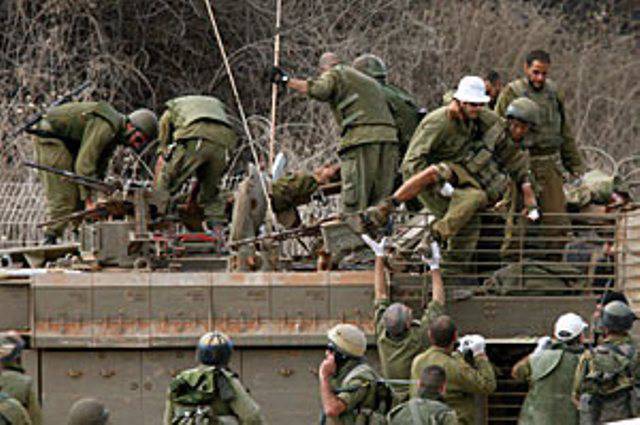
The issue of exploitation is a special subject - this is both the engine and the tank transmission and the resource of components and assemblies is also a tank one. Money is not small. Even the United States cannot afford to use Akhzarit as a “fly” or “workhorse”. That is, it is impossible to replace BTR-80 with similar vehicles in the Armed Forces of the Russian Federation today and in the near future.
Of course, the idea of refitting outdated tanks in an armored personnel carrier deserves attention. In our country, the slogan seems to go: “All unnecessary things will be scrapped, we will collect scrap metal!” As a result, T-64, T-72 and T-80, which have not yet worked out with a full set of DZ blocks and on-board screens, are simply disposed of with tears in their eyes (BTRZ workers).
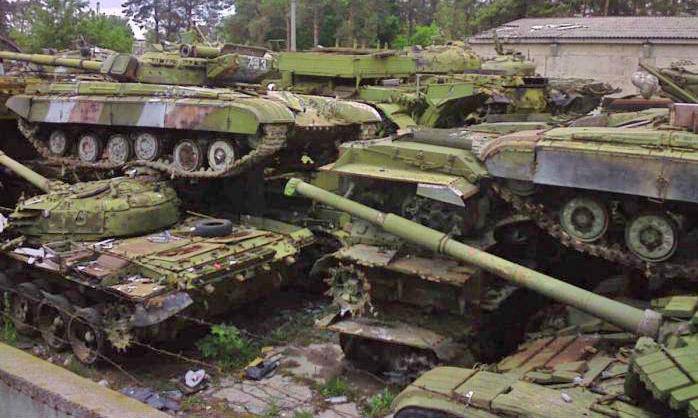
Yes, they could be converted into heavy armored personnel carriers or, for example, the BIS. But not only the domestic industry makes a difference - no one else has made such machines except Israel. The Germans, for example, conscientiously saw their “Marder” and outdated “Leopards”, both the first and the second.
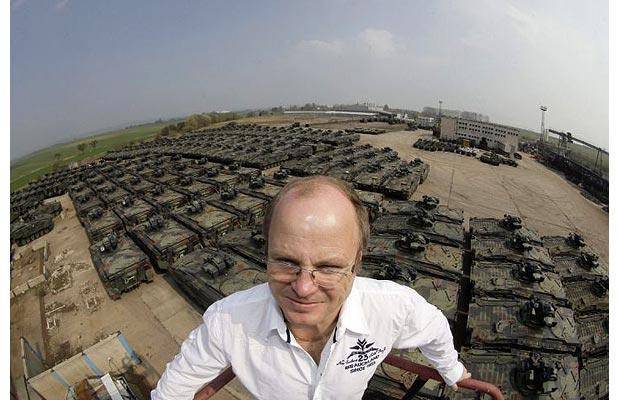
Why, there the Germans, the Israelis themselves are no longer engaged in alterations, and this despite the fact that they have something to convert, for example, American tanks M60.
And after the appearance of this material, you can leave all disputes at all (http://topwar.ru/22142-izrail-sozdast-novoe-semeystvo-bronetehniki.html). Even the authors and owners of Akhzarit and Namera want to have something simpler and easier in addition to them: “The Israeli Defense Ministry intends in the near future to launch the program for developing a new family of light armored combat vehicles adapted for combat in urban areas . The prospective family has already received the name "Rakiya"; It will be created on the basis of the main battle tank “Merkava” Mk.4 using part of its technology, but they will not be tanks. Most likely, the new cars will receive a wheeled chassis, the Merkava Mk.4 will be twice as light (its weight is about 65 tons) and will be much faster and more maneuverable. ” This material is also available on the "Military Review".
Why is the successful experience of Israel not adopted by other countries? Maybe because it is not difficult for Israel to keep 500 "Ahzarits" in the service of the army, given the financial compensation paid annually by Germany, but the needs of the armies of the USA, China, Germany and Russia in armored personnel carriers are much higher. And everything as always rests on money.
Again, and who ever said that they are the best? Has anyone compared them with the Russian BIS? Moreover, the BIS has a huge potential for modernization and improvement, in contrast to the overweight “Akhzarit”, “Pumas” and “Namera”. It should be a shame, comrades!
Hack and predictor Aviator:
- Israeli heavy armored personnel carriers “Akhzarit”, “Puma” and “Namer” are indeed the most protected foreign landing armored vehicles, but they are not armored personnel carriers and not BMPs. The scope of work that is assigned (assigned, for example, in Afghanistan) to domestic armored personnel carriers and infantry fighting vehicles, they will never perform;
- It is necessary to focus on heavy BTR "Ahzarit", "Puma" and "Namer" when developing new domestic counterparts, but you need to develop a different type of car (for more details on this, see paragraph 11);
- author's opinion: domestic BIS - the most protected heavy BTR / BMP in the world.
9. Unsuccessful arrangement of fuel tanks BMP-1 (2) in the aft hatches of the troop compartment.
Immediately ask the question "experts" (that is, to themselves): "Where is this location successful or will it be?" We use the method "by contradiction" (the method of "exceptions"), based on the fact that we are creating a floating car with a low silhouette, strongly limited in mass and size and intended for attacking actions.
A) Outside the hull. Easily accessible for refueling, easily accessible for enemy fire. Hit and penetration of such tanks is not terrible for the crew, but deadly, since the car will lose its course and will become a well-highlighted target. In addition, such a machine can swim only vertically before meeting with the bottom. Hang on the stern can not be - there are hatches of the troop compartment. Option disappears.
B) Inside the case. The consequences of the hits are absolutely the same - fatal, but it will be more difficult for the enemy to do this, because the tanks will not be visually visible. Other things being equal, we choose this option and then determine where to put the tank.
1) Into the bow in the MTO compartment. The crew is protected as much as possible. Well, even if after the penetration of tanks, the MTO will burn out completely - the crew will have time to leave the car. That's just the weight distribution will not allow the car to float, especially without landing, well, except that vertically with his nose down. Not that!
2) In the fighting compartment. There is simply no place in it. Exclude option.
3) In a shelf under the roof. Possible only in the troop compartment. In this case, it is necessary to record in the landing of schoolchildren or dwarfs, so that they can crawl into such a department. Do not go!
4) In the floor of the bottom. The variant is similar to item 3).
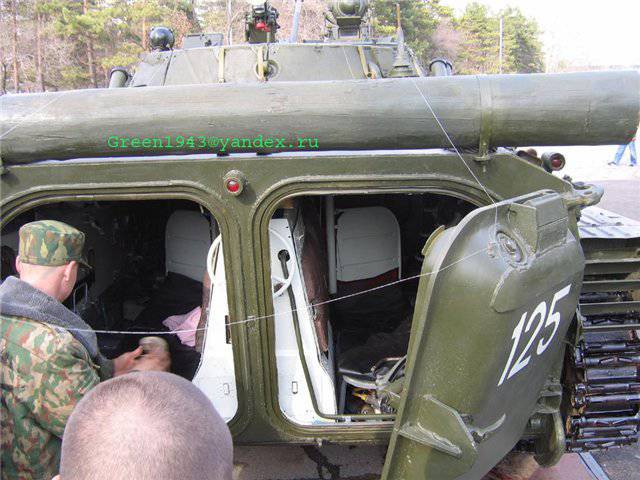
5) Somewhere else. It is clear that it is impossible to enter the MTO department - we will not be able to swim, there is nowhere in battle - there is a turret, ammunition and two crew members. It remains the troop compartment. Nobody can be crammed in here, everything is already crowded without it. An ideal place for swingers.
Conclusion: in view of the technical requirements, the designers made a rational reasonable and logical decision to place the fuel tanks in the stern hatches, which are protected by the maximum possible measures.
10. The BMP-3 with the Bakhcha combat module has the highest firepower.
It is very likely, but ... We recall the purpose of the BPM and the tasks performed by it and ask ourselves the question: "Why does the BMP have so much extra iron (about 4 tons) when there is an ACS and other specially created and armed vehicles based on them?" In general, the BMP-3 itself is a special subject, which is only one consideration of the chassis from the point of view of the theory of the layout of combat vehicles. But we confine ourselves to “Bakhchoy”.
Battle module "Bakhcha-U". His birth is associated with the demands of the military to significantly increase the firepower of the BMP-3 developed at that time. Thanks to these requirements, the low ballistics gun 2А70 was born. What was the result?
Saying about the Bakhcha-U module, that it is an absurd addition to the crazy BMP-3, is like praising. Extremely hard, but as it is; here the opinion of the author coincides with the views of many industry experts and the military, directly operating the machine. So, who cannot adequately perceive objective criticism, let him stigmatize us, or better still, beats his head against the wall).
Dear FCS, “sharpened” under guided ammunition, 30-mm gun and PKT, 100-mm gun 2-70. And also in the fences on the chassis of the AGS-17 or PKT. In short, blinded from all that was.
The place of the PCT is explicable, obligatory and unshakable. Until such an equally cheap and effective means of fighting the nearby infantry infantry troops of the PKT will be in the "main force".
AGS-17, especially mounted on the chassis, is a very profitable and desirable means of fire. He would be in a pair with the 30-mm cannon, and enemy infantry within the 1,5 radius of a kilometer. But how stupidly on the BMP-3 they were installed in the fenders! All the power of the AGS-17 talent to fire on a hinged trajectory was torn off, thrown away and forgotten in favor of the course barrage fire weapon. But the BMP does not need it, it is not a three-turreted tank. Unlike "Berezhka", "Bakhche" AGS in its original form and magnificence did not get.
As mentioned earlier, it is easy to disable a tank with just a few hits of 30-mm projectiles. The main thing is that they are accurate. That is, it is not necessary to arm the BMP with a tank gun to fight armored vehicles. This means that the module and the whole machine cannot be abused for arming the 30-mm cannon.
To fight with openly located manpower, manpower in the trenches and fortifications that 30-mm, that 100-mm gun is not enough. For action on similar targets, it is preferable to have a mortar capable of delivering ammunition to the target without fortifications. By the power of the action that high-explosive, that fragmentation 82-mm mine will give odds similar to 100-mm shells. Actually machines with similar weapons have already been created and are beginning to enter the troops (SAU 2K32, 2C34). What is the merit of 2А70?
According to testimonials, the stated sighting range in the 4000 m was not confirmed by accurate hits. You can shoot at 4000 m, but it's impossible to get somewhere, or more precisely. That is, if the OFS is fired, the BCS generally has an effective range of less than 1500 m. And why then a gun that does not cover the 30-mm gun that is already on board with an effective range? In any case, let's say, a little expensive.
The love of guided missiles has no limits. Expensive, but refined and tasteful. Already 8 pieces on board! From OBD we can say one thing - they do not like military guided weapons. Especially to serve his OMS. In any case, the number of such shots is already a moot point.
To say bad things about what he personally worked with, of course, is not entirely pleasant, but still ... Let us omit general questions, and now consider the side that is affected extremely rarely - maintenance of equipment. Here, BMP-3 with “Bakhchoy” is out of competition for costs. God forbid you to conduct THAT 2А70 and remove the trigger mechanism !!! Advice to conscripts - to mess around, contract soldiers ... You knew what you were going for. My advice and request to Satan - make it a torture for bad designers! After all, this simple operation takes several hours.
The manual for the BMP-3, created by the minds of the PCU, describes the maintenance of the 2-70 gun. It is here that the true essence of the designers of the machine manifests itself. None of them, it seems, didn’t bother to climb into their own child. It’s one thing a cannon, and it’s quite another thing a weapon mounted in an BMP tower with an 2A42 (2A72) gun coupled to it and a PKT machine gun. In any case, the operational documentation should not be done. Shame!
So, to begin with, the trigger mechanism of the 2А42 (2А72) cannon is removed and removed so that it doesn’t stop them from crawling. Then the links of its tape diverter are removed in the same way (a metal multisection box-shaped gutter leading from a rotating polik to a gun), because the mechanism buffer lies on them. This is done in a half-ride on outstretched hands, observing with one eye the gap between the elements of the "design" of the interior, with its head resting on some regular iron figovin, which in the fighting compartment simply does not count. Finally, with the help of a sledgehammer, the desired mechanism is taken out, weighing over 30 kg, and with all the same outstretched arms is removed to the roof of the tower for maintenance. And now, in order to put it in place, you will have to not just repeat everything in the reverse order, but spend twice as much time and effort on it. I don’t know why, but neither the mechanism, nor the studs of the belt diverter links (resting on the buffer) stand in place, they do not want to persuade all the same sledgehammer, which has nowhere to swing. Moreover, all this was done by us on an already half-disassembled (!) Car.
As a result, one MOT 2А70 takes time, if measured in hours ... In short, in a combat situation it is easier to either remove the module from the car on the crane, so that its nodes have normal access, or it can be changed at all to a working one, it will be faster. In general, no words - one mat. Only crawl to the heels of the links of the box worthy of a medal for courage. Those who are familiar with the situation, will not lie. And this is just one example. To torment the crew with this is simply inhumane, even for the Russian army (I would like to say especially, but my own experience did not allow). Let it be better at this time the crew TSP will pass.
What we have in the end: FCT, which simply has nothing to replace, obstructed AGS-17, 30-mm gun, aimless 100-mm gun 2-X70.
Hack and predictor Aviator:
- The numbers of firepower of the BMP-3 with the Bakhcha combat module are too high, but even the available firepower for the BMP-3 is redundant and not needed, armament is irrational. The module (thanks to the 2А70 product) is a ballast, the weight of which with great success would be taken by additional armor;
- to hide behind the demands of the military for increasing firepower with the installation of the Bakhcha-U combat module is an alarming sign both for the domestic defense industry and for the customer.
11. The buoyancy property of BTR, BMP, BMD is not necessary, it is better to send all the reserves in favor of security. And bridges and so will be, where the tanks - there are bridge laying.
To the issue of buoyancy. In the attack on any theater of operations (with the exception of deserts), troops will be forced to force various water barriers - rivers, lakes, canals, estuaries, reservoirs, flooding sites, and so on. On average, on planet Earth, for example, rivers up to 100 m wide are found every 35 – 60 km, 100 – 300 m wide - through 100 – 150 km, and 300 m wide - through km. In other words, during the offensive, units will have to overcome, on average, one medium water barrier and several small width obstacles on average.
According to the experience of the offensive actions of the Second World War, the forcing was carried out effectively, as a rule, only in a short time, suddenly for the enemy and on a broad front. Crucial to the success of forcing had (and will have in the future) a gain in time. Yes, the events are long-standing ...
However, tactical exercises conducted during the Cold War in the armies of the NATO countries, along rivers, canals, lakes, were usually equipped with powerful defensive lines, fire barriers, flooded areas, and nuclear mines. Thus, potential adversaries do not deny that they will actively use water barriers, and both natural and man-made ones. Moreover, these obstacles are becoming insurmountable also for the likely opponents themselves, shackling their own maneuvers.
In general, depending on the situation, the crossing of a water obstacle can be carried out in various ways: on the move, with preparation of forcing before units approach the water obstacle, or with the deployment of the main forces near the water barrier, after additional preparation for forcing in a short time. In all cases, the success of the forcing is determined by careful preparation, well-organized enemy reconnaissance and water obstacles, ensuring surprise, reliable air cover of units, powerful enemy fire engagement, timely deployment of cross-over facilities and ferry equipment, and measures to prevent the accumulation of personnel and equipment. at crossings, as well as strict observance of security measures.
If all of the above are foreseen before each crossing of a water barrier, there can be no question of the development of an offensive and success. Consequently, units need mobile transportable vehicles to overcome water obstacles, and preferably armored ones, the very ones that they propose to refuse.
It is clear that the most expedient and attractive way to overcome water obstacles - on the go. The essence of forcing off the move lies in the rapid exit to the water obstacle in the order of battle in which the battalion attacked, quickly overcoming it on a broad front after a short fire preparation, a decisive attack of the enemy and the non-stop development of the offensive on the opposite shore. The advantage of this method of forcing is that it provides the necessary gain of time, the suddenness of striking the enemy, the high rate of advance. What is important is the capture of the crossings and the timely delivery of the crossing means, until the retreating enemy regrouped his forces and turned to a counterattack or a powerful echeloned defense.
In accordance with the plan of actions for forcing and the combat mission assigned to the units, their combat order is created. It must ensure the decisive destruction of the enemy on its shore, the rapid forcing of a water obstacle and the continuous buildup of combat efforts during a battle on the opposite shore.
The advancement of subunits to the water barrier is carried out at maximum speed. If a unit operates as part of a forward detachment, its task is to reach the water barrier as soon as possible, bypassing the enemy’s individual strongholds, to capture the remaining ferries and sections suitable for forcing. Crossing units carry on existing bridges, as well as on floating combat vehicles and amphibious vehicles, on the opposite shore, they seize profitable lines and keep them until the main forces approach.
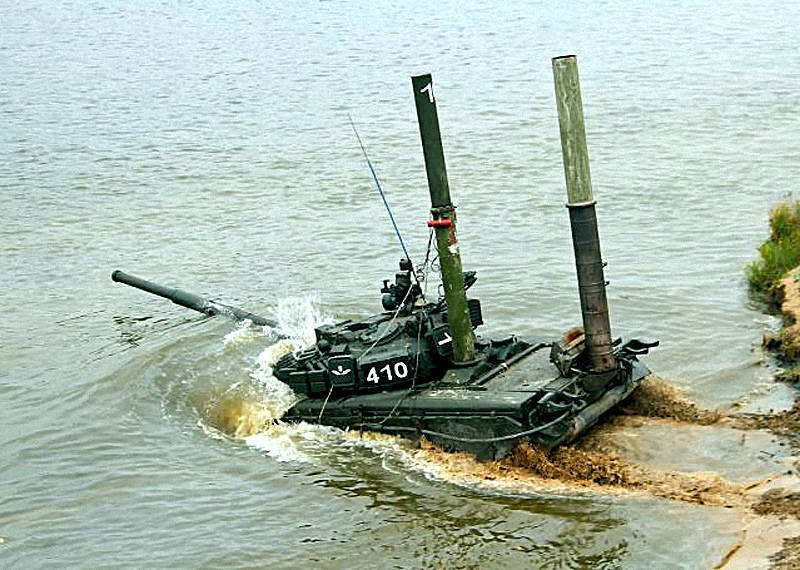
Tank units operating as part of the main forces are shipped simultaneously with the first echelon on captured bridges and fords or by means of amphibious assault vehicles. After mastering the opposite shore, part of the tanks can be shipped under water. Having overcome a water barrier, tank divisions, without stopping, go to their own directions and carry out the assigned tasks.
The transfer of artillery attached to the subunit, as well as anti-aircraft units, is usually carried out on floating machines and paratroopers in such a way as to ensure continuous fire support and cover for the advancing units on the opposite shore.
That is, in any case, floating machines are needed, the more they will be, the better. What if an insidious enemy, like the Red Army once, undermines all the bridges during a retreat? It remains only to understand him, forgive and release, instead of catching up, grabbing, finishing him in his own lair.
Of course, the landing should be defended as it should, but you shouldn’t go as far as fanaticism, because by and large, as we have established earlier, modern 120-125-mm ammunition of tank guns is the same as to destroy a tank, BMP, BTR or BMD. In the duel of tanks, the one who gets before will win. Therefore, the thickness of the armor of the forehead of the hull or tower is not strictly important. That 200-mm, that 20-mm armor will lead to losses in personnel and equipment, but 20-mm armor will allow technology to swim.
It is not possible to fully replace the buoyancy property with the use of OPVT (equipment for underwater driving of a tank) not only because of the limitations imposed by the technical and operational characteristics of the OPVT itself (extreme excitement, depth of obstacles to be overcome, time for preparation, protection from small arms fires and explosions of projectiles and mines near carrier). Often, overcoming a water obstacle ford is hampered by the characteristics of the bottom, which may be a layer of silt several meters deep (true for obstacles encountered on the vast expanses of the fatherland). In general, OPVT is not applicable for landing armored vehicles from amphibious ships, and especially its return.
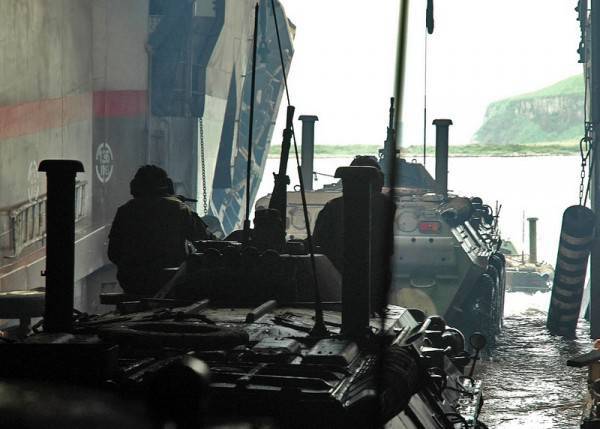
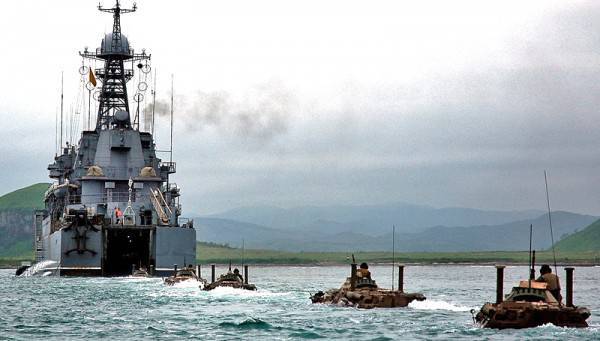
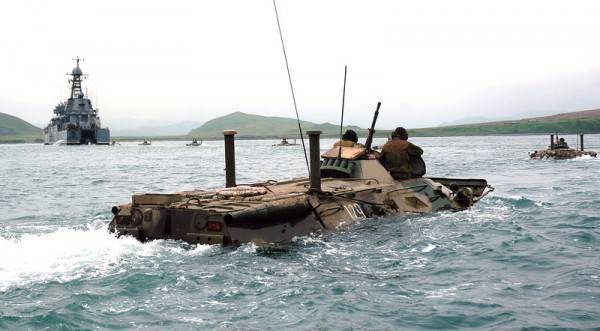
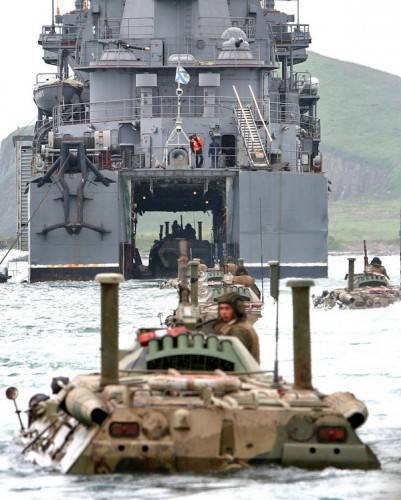
Some "experts" oppose buoyancy with an affordable opportunity to carry a bridge with them. The bridge ... To carry ... With you? In the first echelon ?? We are not lazy and look at the performance characteristics of the domestic pontoon park. Finds the following:
1) PPS-84:
- 120-ton floating bridge: bridge width - 15,5 m; roadway width - 13,77 m; full bridge length - 702,2 m; pickup time from the complete set - 3 h;
- 90-ton floating bridge: bridge width - 11,89 m; roadway width - 10,11 m; full bridge length - 932,6 m; pickup time from the complete set - 3,5 h;
- 60-ton floating bridge: bridge width - 8,28 m; roadway width - 6,55 m; full bridge length - 1393,4 m; pickup time from the complete set - 2,5 h;
2) PP-91:
- 60-t bridge: the length of the bridge from the park kit - 224,4 m; bridge pickup time - 25 min; maximum flow rate - 3 m / s; extreme excitement - 1 score;
- 90-t bridge: the length of the bridge from the park kit - 165,2 m; bridge pickup time - 20 min; maximum flow rate - 3 m / s; extreme excitement - 2 points;
- 120-t bridge: the length of the bridge from the park kit - 129,2 m; bridge pickup time - 15 min; maximum flow rate - 3 m / s; extreme excitement - 3 points.
It is clear that the parks are not made of inflatable balls, but of links, which also need to be delivered, and, as a rule, they are located on the wheeled chassis. For example, the PPS-84 fleet includes: 192 river links with pontoon vehicles, 24 coastal links with pontoon vehicles, 12 lining sets with liner vehicles, 72 towing and motorboat BMK-460 towing boats, XNXXXXXXXXXXXXXXXXXHXXXXXHXXXXXXXXXXXXXXXXXX-12 KrAZ-24 vehicle; PP-260: 91 motor links MZ-8; 235 towing motor boats BMK-4; 225 River Link; 32 coastal links.
So, the troops awaiting the crossing will have to wait a bit under the enemy's hurricane fire, bravely taking fire on themselves without being able to maneuver. Even in the “truncated” version of the 100 units on a wheel, the 10,3 length is a meter with a minimum distance between links when moving as part of a column in 5 m (whereas, according to the 25-50 m standard), this is an uncluttered uncolored 1525 m column. Yes, and the promptness of building a bridge (even at 1 hour) for offensive actions is clearly not satisfactory. The battery of the enemy's self-propelled gun will destroy engineers with the entire fleet fifteen kilometers from twenty.
Again, no one is trying to build a bridge without an occupied bridgehead. A springboard is definitely not a coastal strip in 100 m to the nearest raspberry bushes. And who and what will capture it? An armored MTU will master the 24 meter of a water barrier, you need more - build a bridge under the whistle of bullets, a hail of fragments, shell explosions as you wish.
For example, the BMP-3 with all its “hurricane” firepower occupied a springboard on the other side. The enemy will naturally try to destroy it with all his might, and, consequently, the battle will be hot. While consuming 6-7 shells per minute, the main caliber will be silent after eight minutes, the 2А72 will go out, say, in another five. So what is next?
If there are few of these arguments in favor of buoyancy, then I recommend contacting here: (http://topwar.ru/22152-poligon-most-za-chas.html). Well, how does the idea of carrying a bridge with you look now?
Nor should we forget that all Soviet weapons were intended not to capture the whole world, but to repel possible aggression by capitalist countries. Considering the level of development of our infrastructure (the number and length of paved roads, the number of bridges able to withstand heavy equipment, ferries and river freight transport, the abundance of lakes, rivers and wetlands throughout the country), the ability of equipment to overcome water obstacles by swimming is very justified . Especially when all these crossings will be blown up, so that the damned capitalists will suffer and build new crossings that can withstand their equipment and autobahns for the MRAP.
Hack and predictor Aviator:
- the bridge builders will tirelessly and faithfully follow the tanks, but their forces are limited, it is not advisable to use a pontoon park in offensive operations, especially in the first echelon;
- no reserve by weight for the sake of buoyancy, used for the sake of security instead of buoyancy, will not allow the enemy to sustain the shelling of equipment waiting for their turn to cross;
- considering that even frontal armor of modern MBT is difficult to resist with anti-tank ammunition of MBT cannons, anti-tank mines, then defending BMP like tanks does not make sense. The level of 30-mm projectile and 40-mm grenades is a sufficient level;
- it is hard to book an BMP forehead capable of swimming, justified, the board and the stern is not advisable. In general, let us recall why BPM is needed and we will understand that attacking a BMP from the stern is possible only when using the machine for an inappropriate purpose;
- buoyancy expands the capabilities of the machine, contributes to the speed of application and increase mobility, transportability; buoyancy property for BTR, BMP, BMD is mandatory, especially for domestic ones.
12. BTWT is poorly protected from aviation.
Unambiguously answer this question on the move will not work. It is necessary to stipulate in advance the conditions for their meeting on the battlefield: will it be obsolete tanks of the Iraqi guard in the desert against the air forces of the army and the air force fleet The USA, on the contrary, the US tanks against Iraqi aviation or the combined arms battle of two superpowers (well, or at least roughly equal in military "strength" countries).
In the first case, everything is clear - the tanks are left to their own devices, air defense systems and friendly aircraft do not hide behind. Aviation of the enemy allocates significant forces directly to defeat enemy armored vehicles. Each tank of Iraq has one aircraft and a helicopter, not counting more modern direct analogues (exaggerated). Conclusion: Iraqi tanks are doomed to accept the death of the brave, performing combat missions and engaging in battle with superior enemy forces.
In the second case, tank duels are expected, because the Iraqi aviation will have something to do - the struggle for existence instead of performing fire tasks on enemy armored vehicles. The US Air Force is unlikely to allow a neighborhood in the sky and will use all available resources to gain air supremacy.
Well, now the third case that interests us the most. Immediately, we note that 100% anti-tank aviation does not exist, unlike artillery. All airplanes and helicopters are universal (multipurpose) combat vehicles capable of destroying armored vehicles on the battlefield, if necessary, using a wide range of special ammunition. All this to the fact that in the course of full-scale hostilities, aviation again will have more strategic priorities than defeat tanks.
The main such goal - the conquest of superiority in the air. Helicopters, although they have the ability to fight airborne targets, but they cannot fight with this aircraft. Therefore, it is logical to assume that it is on their shoulders will be assigned the responsibility for the destruction of armored vehicles. But, as long as the enemy aircraft have superiority in the air near and on the line of combat contact, the use of helicopters will be associated with large losses. Also, given the successes of modern air defense systems, "sharpened" under the fight with unobtrusive low-flying, high-flying, highly maneuverable high-speed targets (airplanes), the prospects of helicopters that fell into their area of operation are unenviable, taking into account the remoteness of their characteristics of visibility, speed, maneuverability from " heights "characteristics of aircraft.
At the same time, it is not a secret that air force facilities (airfields) are much more priority targets than tank forces. In the case of the start of full-scale hostilities, the surviving aircraft will remain a low percentage, and to do it, as we have already noted, will be what. To compensate for the loss of aviation with the help of industry is currently not possible, since the production cycle (not to be confused with the creation cycle) of a modern helicopter or aircraft is weeks and months, and this is subject to the integrity of the production capacity of dozens of suppliers of components and parts for their production. At the same time, when the airfields and hangars will be objects of special attention, tank forces will begin ground operations.
By the time the aircraft can come to, the tank troops will be able to approach them at a distance of throw. It is worth noting that at full combat load, the cruising range of tanks (despite the fact that they can be relatively painless to hang additional barrels of fuel) is equal to the radius of action of attack helicopters and airplanes, which can increase the range only by replacing missiles or bombs with an additional tank. But the time and cost of maintenance and repair of armored personnel carriers and operation are significantly lower than those of aircraft.
Thus, one cannot rely on the omnipotence of aviation in the fight against armored vehicles, especially in full-scale military operations. Tank units, as a rule, are supplemented by air defense systems (ZSU, ZRAK), operating with them in the same order and covering helicopters and attack planes with the maximum range of the anti-tank missile system. Little would prevent armored vehicles from interfering, maneuvering and firing back in order to escape from under the fire of aviation.
What is dangerous helicopter or attack aircraft for the tank? Of course, with their weapons and the fact that they can carry out quick maneuvers to attack armored vehicles in the least protected areas - the roof. And for this, he is arming with artillery weapons (20-30 mm automatic cannons), ATGM, conventional and special cluster bombs (of course, must be dropped from a great height over armored vehicles), unguided rockets. Let us consider in more detail each type of weapons.
Bombs
There is a wide range of bomb weapons from free-fall OBs to adjustable and guided cluster bombs with anti-tank submunitions. This whole nomenclature is quite applicable for action on armored vehicles. But there are limitations in their use, fair for both the entire range of bomb weapons, and for its private representatives.
Let's start with the fact that in order to use their weapons, a helicopter or attack aircraft must secretly approach the armored vehicles, that is, at low altitude, for air defense and enemy aircraft. Also, unnoticed, he must detect the target and prepare for its attack. These conditions are quite difficult to fulfill if the fighting does not take place in an open field or desert. It is necessary to drop bombs to the carrier in such a way so as not to fall into the zone of scattering of fragments after they break.
To hit a free-fall bomb exactly even in a fixed target is not an easy task. To compensate for inaccuracy designed powerful bombs of large caliber and cluster bombs. The first, if they miss, can turn over the nearby tanks, the second cover the area with submunitions, in which the target is located, so that one of them is guaranteed to fall into it. A simple measure of protection for armored vehicles in this case is to increase the distance and intervals between adjacent vehicles.
Another thing is doroguschih managed and adjustable bombs. With obvious advantages in the achievable accuracy of hits, these types of bombs have disadvantages in the form of high costs and the availability of opto-electronic suppression tools on armored vehicles, which we talked about a little earlier.
ATGM
The use of ATGM is similar to the use of UAS, which were mentioned earlier, and has the same drawbacks, except that the “let-forget” principle is implemented in modern aviation variants. In one go the helicopter can make two or more launches of an ATGM.
Automatic small-caliber gun
As a rule, aircraft automatic cannons are similar to guns mounted on armored vehicles, but it can only be applied to the target in more advantageous projections (above). However, the power may still not be enough to destroy highly armored targets.
NUR
The optimal type of weapons as the criterion of "cost-effectiveness", and all-weather, almost unlimited conditions of use in comparison with others.
Hack and predictor Aviator:
- aviation is really dangerous for armored vehicles, which, in turn, is not sufficiently protected from it (by itself, without air defense vehicles);
- in the presence of air defense weapons in the first echelon, actions of aircraft on armored vehicles are no less dangerous for it than for armored vehicles. Given the difference in the cost of the attack helicopter and the main tank, the use of aircraft for the destruction of armored vehicles in such conditions becomes more dangerous for aviation. The loss of aviation is more painful than the loss of armored personnel carriers.
13. BMPT "Terminator", whose machine is so lacking in the Armed Forces of the Russian Federation.
First of all, we are determined for what is this hybrid? For actions in a uniform manner with tanks and the suppression of enemy tank-dangerous weapons (live force, pillboxes, and other means and weapons). Therefore, the armament of the car must be appropriate.
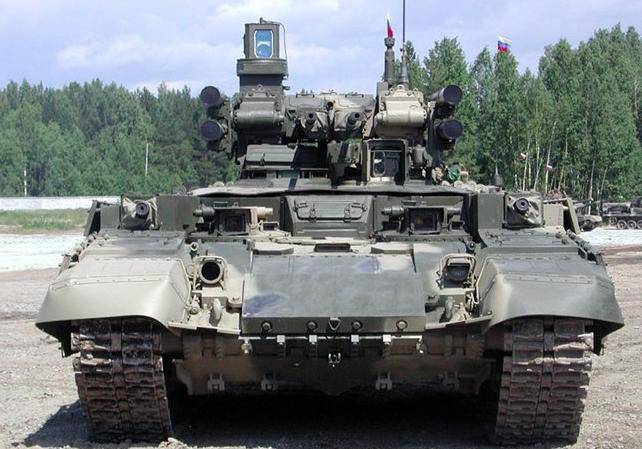
In order not to delve into the analysis of design flaws, we’ll just sort out the question: “Do enough weapons carry BMPTs to support tanks and what is their superiority over vehicles designed to support tanks in combat at present (BMP, engineering vehicles and air defense machines)?”
In the arsenal of BMPT there are two guns 2А42, PKTM, two AGS-17, four ATGM “Attack”. Radically from the weapons of BMP it is no different. At the same time, there are no interference stations, means of fighting enemy aviation, or means of dealing with an enemy located above the position of combat vehicles (in the mountains or in high-rise buildings) either.
Let's start with the thirty. "A queue of eight armor-piercing shells fired from the 2А72 cannon (and therefore 2А42, 2А38, AO-18) is capable of breaking through 120-mm tank armor." It sounds very cool like propaganda - from HBS in Chechnya and Afghanistan, the weak firepower of domestic 30-mm guns was revealed. Quickly cope with a half-meter (on the upper floors of high-rise) brick wall, as well as a concrete panel, they were not able to. And the militants moved to a new position with impunity. OFS with remote undermining in ammunition no. That is, there is no opportunity to fight with hidden human strength (which is expected in the case of enemy defensive actions).
The 2А42 is not a version of the 2А38 anti-aircraft thirty, it was primarily intended for actions against ground targets. The probability of hitting an air target at a distance above 2500 m no more than 10%. Helicopter ATGMs are guaranteed to “work” with the 4000 m. Thus, the 30-mm BMPT guns can only effectively strike openly deployed manpower and light enemy armored vehicles at a distance inferior to the effective range of the CFS tank gun (which has a shell with ammunition in its ammunition).
Both PKTM and AGS-17 weapons are primarily against short range manpower. Installing AGS-17 in fencing niches is not rational, as it does not allow them to fire on a hinged trajectory. In fact, the effectiveness of AGS is reduced to the effectiveness of PCTM, and they duplicate each other.
ATGM “Attack” is designed to destroy armored vehicles and protected firing points. If the tank itself is intended for the first one, then for the second target, the anti-tank missile system is an unjustifiably expensive means of destruction.
Total: support tanks BMPT by and large there is nothing, all the weapons are poorly protected from small arms fire, and the crew is as many as five people. What is the point in BMPT, if the same less protected ZSU will move side by side to protect against enemy aircraft, do they protect the BMP from infantry and light armored vehicles? Then the BMPT turns into a “anti-personnel” vehicle, moreover, it operates only in openly located manpower and duplicates the already existing vehicles.
In fact, BMPT should be highly armored for operations with ZSU tanks (2С6 “Tunguska”, ZSU-23-4 “Shilka”). Their cannon armament will effectively deal with enemy manpower, including on the upper floors of buildings due to the large elevation angles of the guns, light armored vehicles, rocket covers from aviation, and the avionics will allow target detection at long distances and target designation to tanks. In general, it is with such a machine that the enemy’s tank-dangerous weapons can now be carried out with the help of artillery, which will also receive target designation.
Conclusion: BMPT "Terminator" is an unsuccessful model of armored personnel carrier, its purpose does not match. The most successful is a model with a ZSU combat module on a tank chassis, such as the one who did not go to the Donets series ZRPK.
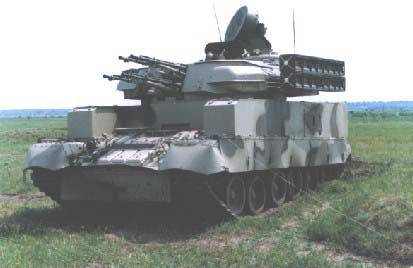

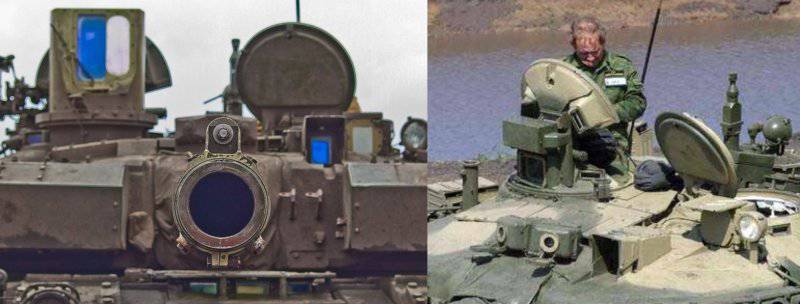
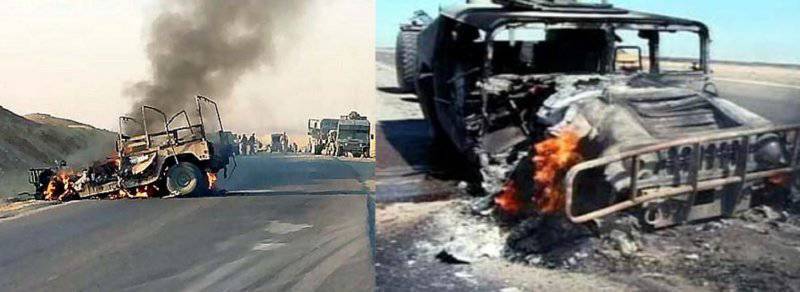
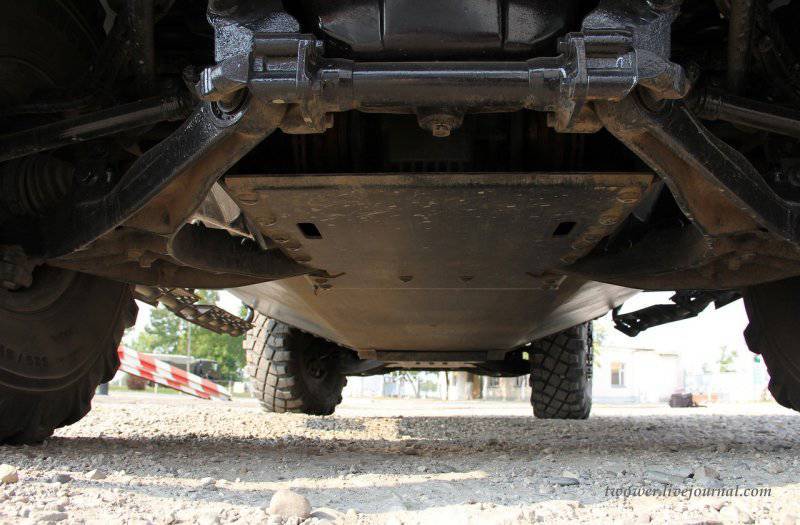
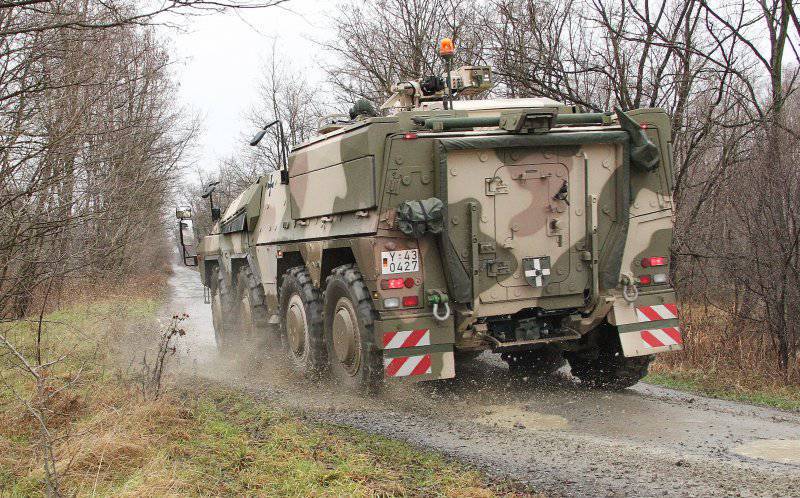
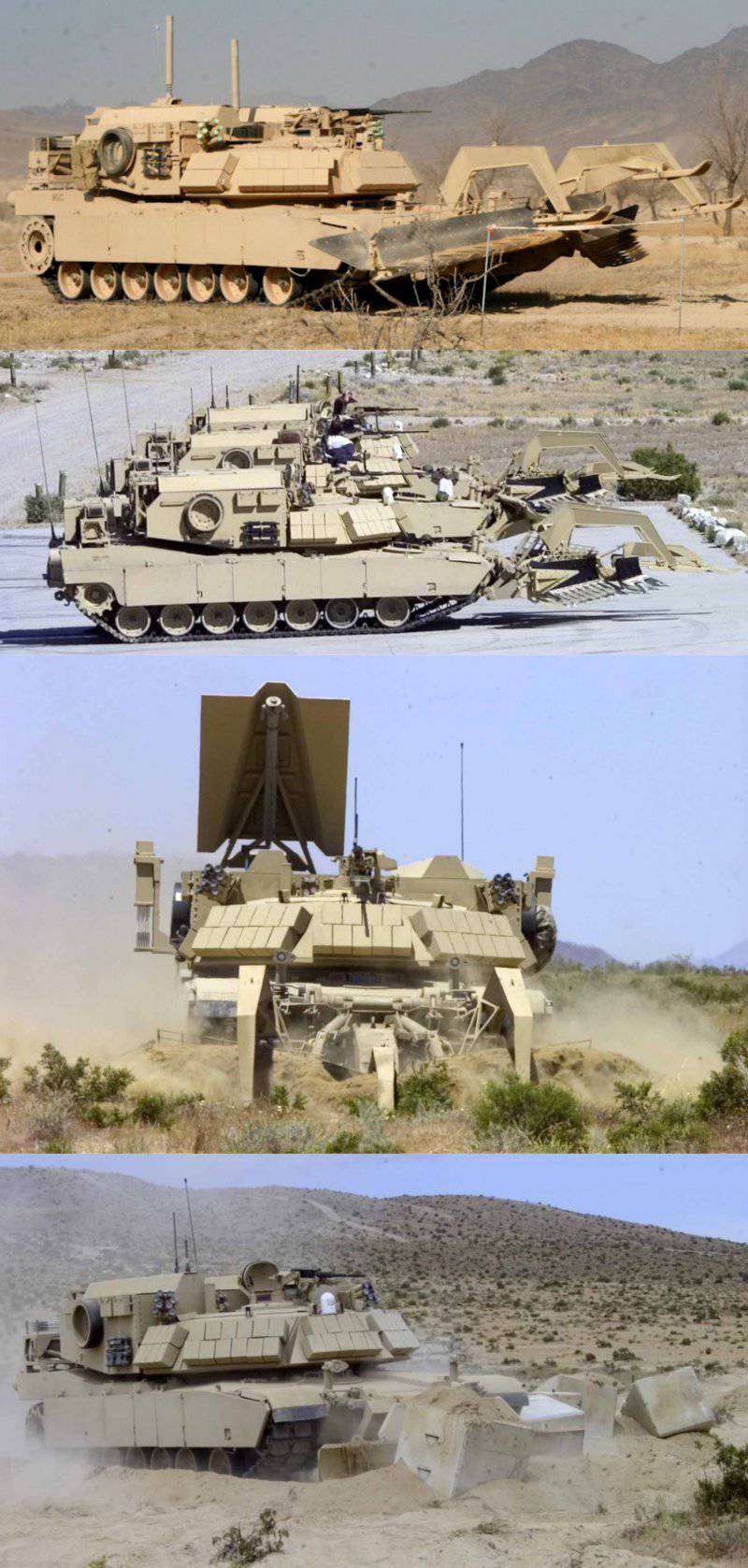
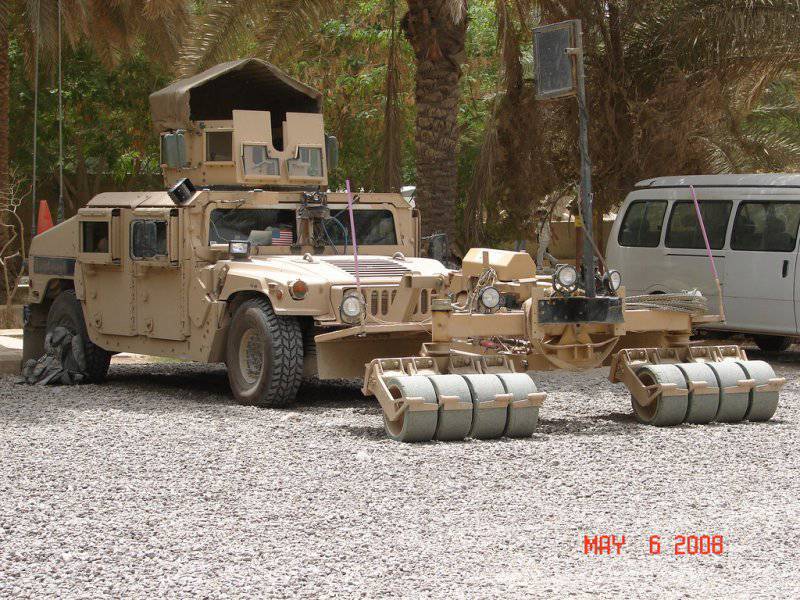
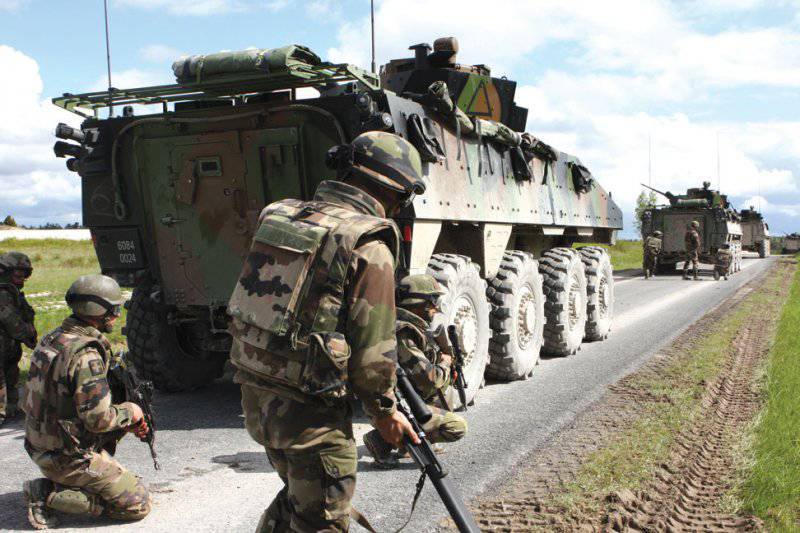
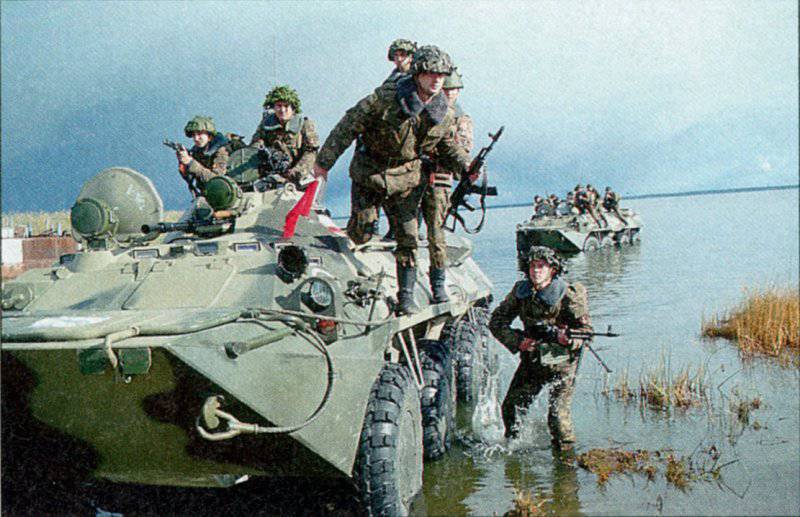
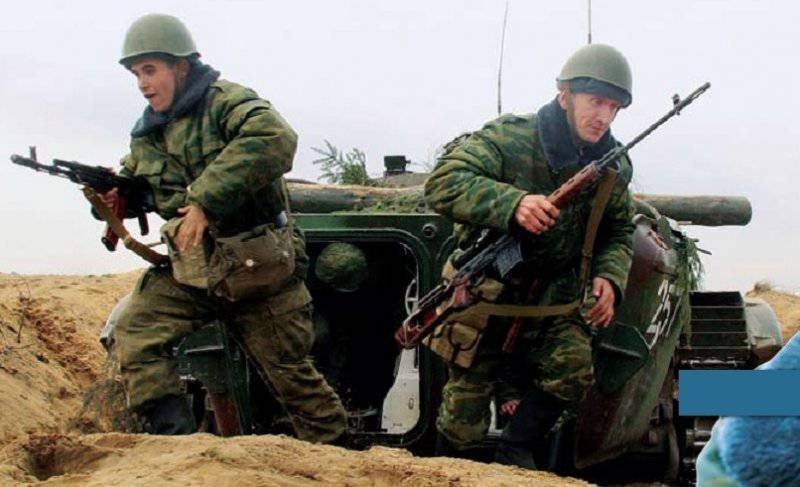
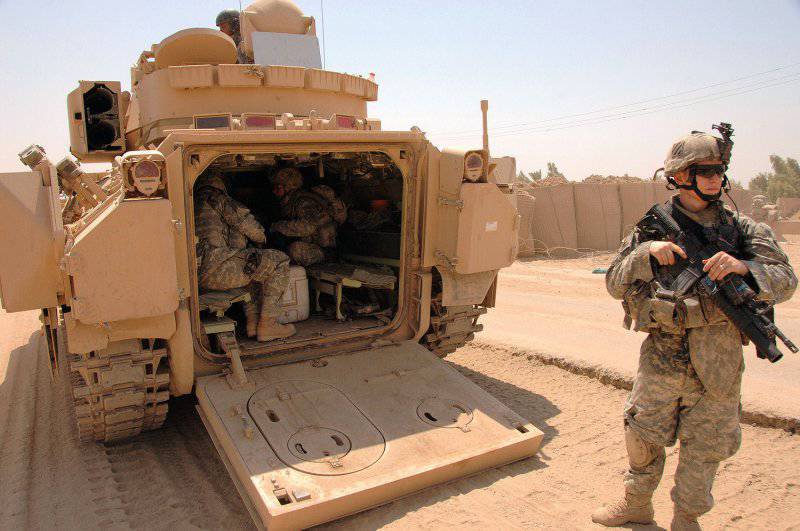
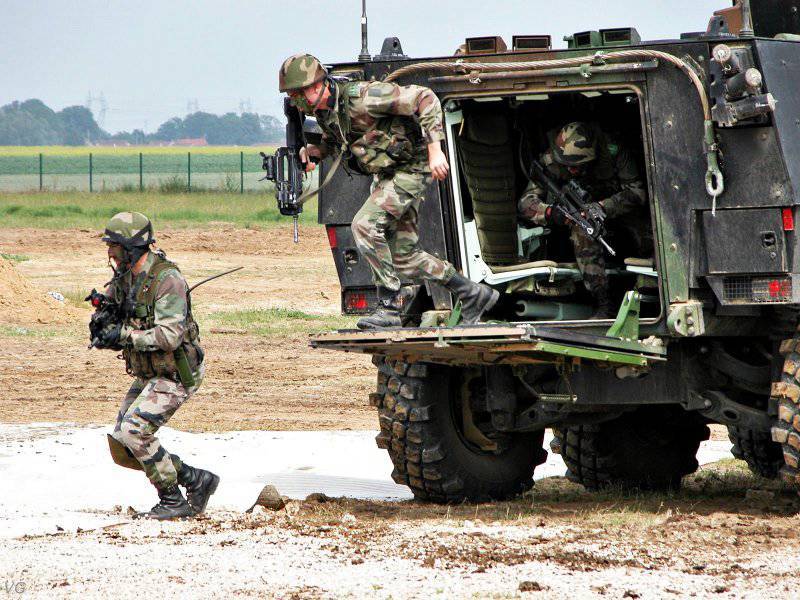
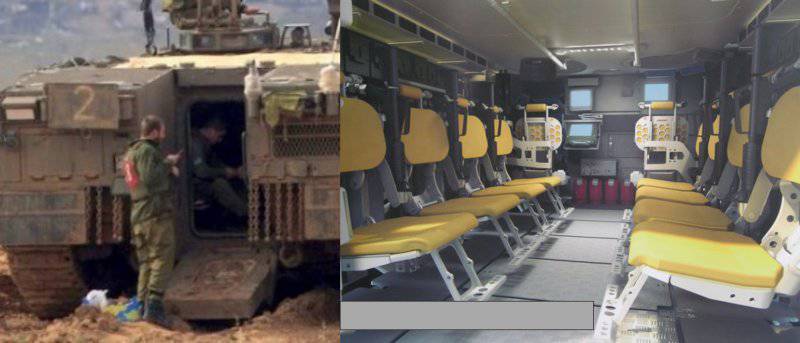
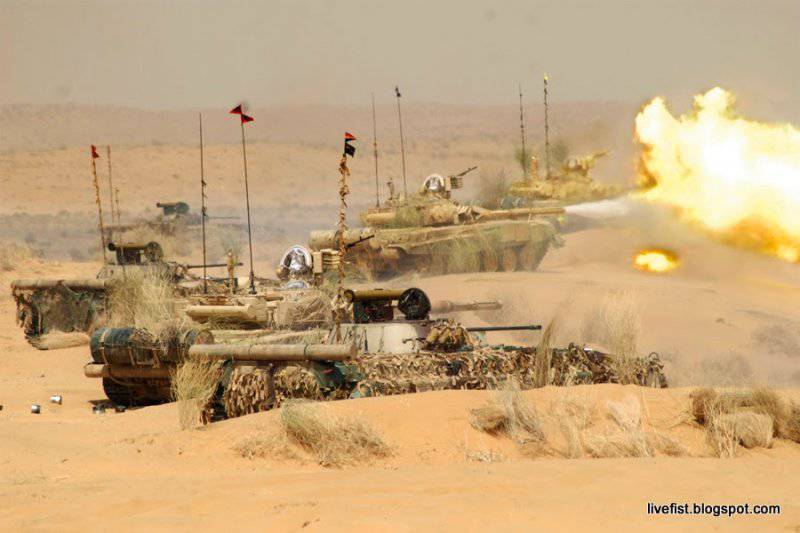

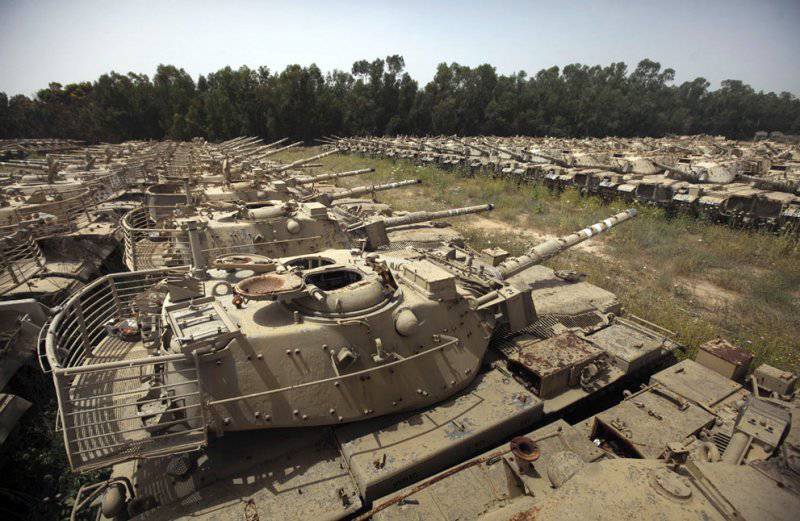
Information